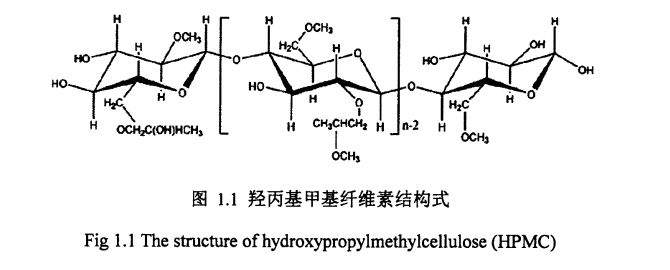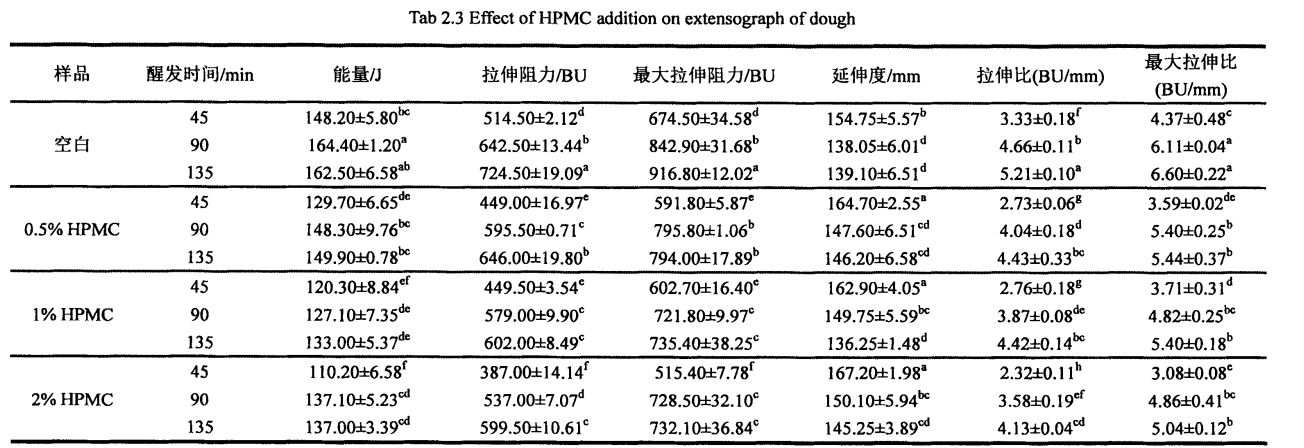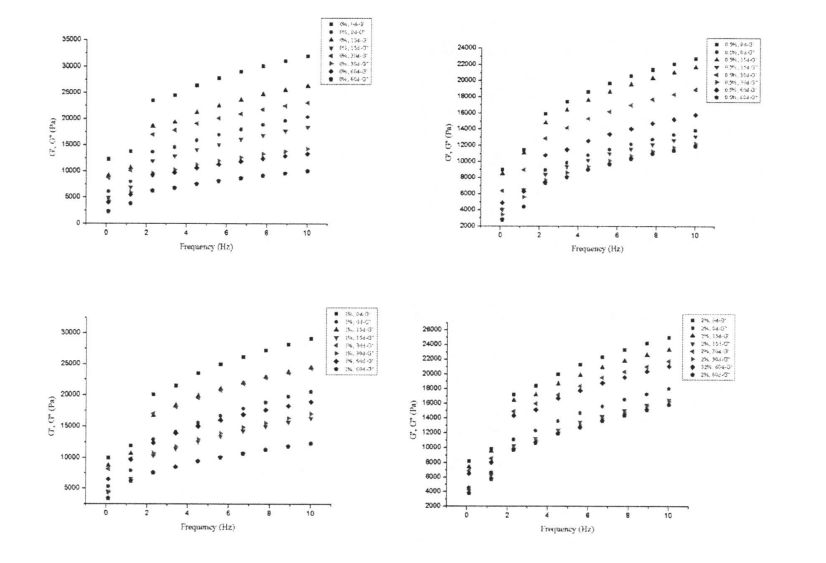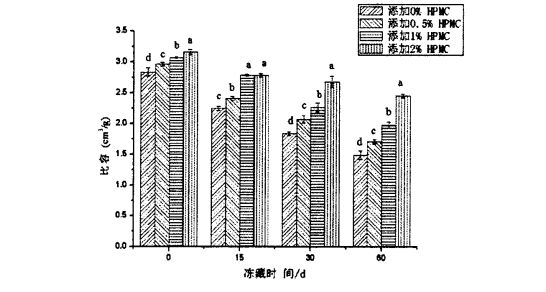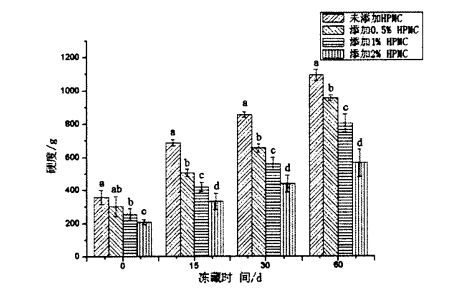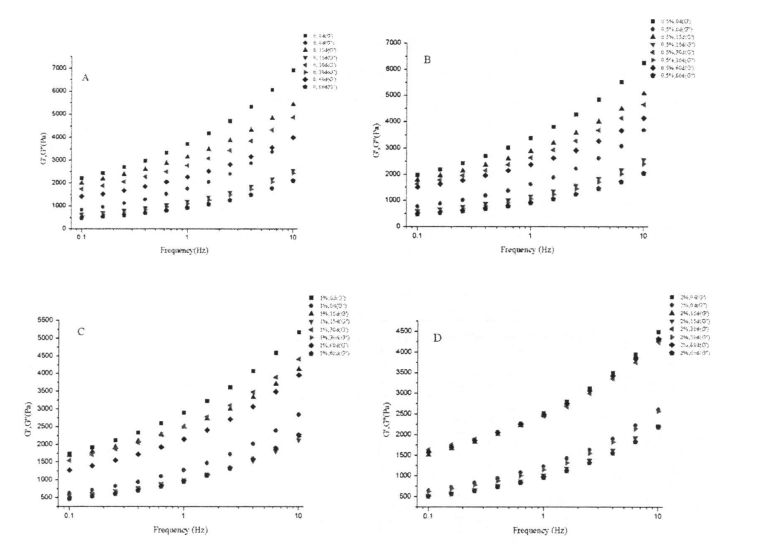Inganta kaddarorin sarrafa daskarewa yana da mahimmancin amfani don ganin samar da manyan abinci mai inganci. In this study, a new type of hydrophilic colloid (hydroxypropyl methylcellulose, Yang, MC) was applied to frozen dough. Sakamakon 0.5%, 1%, 2%) akan kayan sarrafawa na daskararre kullu da ingancin gurasar da aka yi amfani da shi don kimanta tasirin tasirin HPMC. Influence on the structure and properties of components (wheat gluten, wheat starch and yeast).
Sakamakon gwaji da girma da shimfiɗa ya nuna cewa ƙari na HPMC yana nuna sakamakon sarrafa kullu, da tsarin cibiyar sadarwar masu daskarewa ya canza kaɗan. Bugu da kari, idan aka kwatanta da kungiyar sarrafa, takamaiman girma daga cikin steamed burodin an kara shi tare da 2% hpmc da aka daskarewa da kwanaki 60.
Wheat gluten is the material basis for the formation of dough network structure. Experiments found that the addition of I--IPMC reduced the breakage of Yd and disulfide bonds between wheat gluten proteins during frozen storage. Bugu da kari, sakamakon sakamako mai saukar ungulu mai karfin ra'ayi da bambancin yanayin tafiyar ruwa da kuma karawa da tasirin kankara a cikin gulmin abinci. Scanning electron microscope showed intuitively that the addition of HPMC could maintain the stability of gluten network structure.
Starch is the most abundant dry matter in dough, and changes in its structure will directly affect the gelatinization characteristics and the quality of the final product. X. Sakamakon yanayin x-ray da DSC ya nuna cewa dangi na sitestall na sitaci ya karu bayan ajiya mai sanyi. Tare da tsayar da lokacin ajiya mai daskarewa, kumburin ƙarfin sitaci ba tare da kari a hankali ba, yayin da stancovencization stectity, mafi kyawun danko, ƙimar gyaran fuska, ƙimar gyaran fuska) duk ya karu sosai; A cikin lokacin ajiya, idan aka kwatanta da kungiyar ke sarrafawa, tare da karuwar HPMC Bugu da kari, canje-canje na sitaci na sitaci da kuma kayan aikin gelatinization ya ragu.
The fermentation gas production activity of yeast has an important influence on the quality of fermented flour products. Ta hanyar gwaje-gwaje, an gano cewa, idan aka kwatanta da kungiyar ke sarrafawa, ƙari na HPMC na iya tabbatar da haɓaka ayyukan GlatStcellule bayan an inganta yawan ayyukan glatcellular, kuma a cikin wasu kewayon hpmc ya yi daidai da adadin ƙimar.
1.1.7 Hydroxypropyl methyl cellulose (Hydroxypropyl methyl cellulose, I-IPMC) ………. 5
Babi na 2 Sakamakon HPMC game da kaddarorin sarrafa daskararru da kuma ingancin burodi steamed ..................................................................................................................................................
2.3 Experimental results and discussion…………………………………………………………………… . 11
3.2.4 Experimental methods ....................................................................................................... 25
3.3.2 The effect of adding amount of HPMC and freezing storage time on the freezable moisture content (CFW) and thermal stability……………………………………………………………………. 30
3.3.3 Sakamakon HPMC Bugu da kari da daskarewa lokacin akan abun cikin sulfhydl abun ciki (C na peresel) ...................................................................................................................................................... . 34
3.3.5 Effects of HPMC addition amount and freezing storage time on the secondary structure of gluten………………………………………………………………………………………………………………….37
4.1 Introduction .............................................................................................................................. . 44
4.2 Experimental materials and methods ................................................................................. 45
4.3 Analysis and discussion ........................................................................................................... 48
4.3.1 Content of basic components of wheat starch ……………………………………………………. 48
4.3.3 Effects of HPMC addition and freezing storage time on the shear viscosity of starch paste………………………………………………………………………………………………………………………………………. 52
4.3.6 Effects of I-IPMC addition amount and frozen storage time on the thermodynamic properties of starch ………………………………………………………………………………………………………. . 57
Chapter 5 Effects of HPMC addition on yeast survival rate and fermentation activity under frozen storage conditions………………………………………………………………………………………………. . 62
5.1Introduction .................................................................................................................................... 62
5.2 Abubuwan da Hanyoyi da Hanyoyi .................................................................... 62
5.2.2 Experimental methods . . . . . …………………………………………………………………………. 63
5.3 Results and Discussion ............................................................................................................... 64
5.3.1 The effect of HPMC addition and freezing time on the proofing height of dough…………………………………………………………………………………………………………………………… 64
5.3.3 The effect of adding amount of HPMC and freezing time on the content of glutathione in dough……………………………………………………………………………………………………………66. "
5.4 Chapter Summary ........................................................................................................................ 67
6.1 Conclusion ................................................................................................................................. . 68
6.2 Outlook .......................................................................................................................................... 68
Figure 1.1 The structural formula of hydroxypropyl methylcellulose………………………. . 6
Figure 2.4 The effect of HPMC addition and freezing time on the elasticity of steamed bread………………………………………………………………………………………………………………………………. . 20
Figure 3.1 The effect of HPMC addition and freezing time on the rheological properties of wet gluten…………………………………………………………………………………………………………………………. 30
Figure 3.2 Effects of HPMC addition and freezing time on the thermodynamic properties of wheat gluten………………………………………………………………………………………………………………. . 34
Figure 3.3 Effects of HPMC addition and freezing time on free sulfhydryl content of wheat gluten……………………………………………………………………………………………………………………………... . 35
Hoto 3.5 alkama Gluten Pretin Pretrad na Amide III Band Bayan Dalili na biyu ...........
Hoto 3.7 Sakamakon HPMC Bugu da kari da daskarewa Gluten Tsarin Hanyar Mursi ........................................................................................................................................................................................................................................................................................................................................ 43
Figure 4.1 Starch gelatinization characteristic curve ............................................................... 51
Figure 4.2 Fluid thixotropy of starch paste ................................................................................. 52
Figure 4.3 Effects of adding amount of MC and freezing time on the viscoelasticity of starch paste……………………………………………………………………………………………………………………... . 57
Figure 4.5 Effects of HPMC addition and freezing storage time on the thermodynamic properties of starch…………………………………………………………………………………………………………. . 59
Figure 5.1 The effect of HPMC addition and freezing time on the proofing height of dough…………………………………………………………………………………………………………………………………... 66
Figure 5.2 The effect of HPMC addition and freezing time on the yeast survival rate…………………………………………………………………………………………………………………………………... . 67
Figure 5.3 Microscopic observation of yeast (microscopic examination) …………………………………………………………………………………………………………………………. 68
Figure 5.4 The effect of HPMC addition and freezing time on glutathione (GSH) content…………………………………………………………………………………………………………………………………... 68
Table 2.1 The basic ingredient content of wheat flour…………………………………………………. 11
Table 3.2 Effects of I-IPMC addition amount and freezing storage time on the phase transition enthalpy (Yi IV) and freezer water content (e chat) of wet gluten………………………. 31
Table 3.3 Effects of HPMC addition amount and freezing storage time on the peak temperature (product) of thermal denaturation of wheat gluten…………………………………………. 33
Table 3.6 Effects of I-IPMC addition and freezing storage time on the surface hydrophobicity of wheat gluten……………………………………………………………………………………………. 41
Tebur 4.3 sakamakon IPMC Bugu da kari da daskarewa lokacin danko mai lafiyayyen pille .................................................................................................... 55
1)Development of new characteristic steamed buns. Ta hanyar kirkirar abinci mai kyau da albarkatun ƙasa da kuma ƙari na aikin abinci mai aiki da aka bunkasa, waɗanda suke da abinci mai gina jiki da aiki. Established the evaluation standard for the quality of miscellaneous grain steamed bread by principal component analysis; Fu et a1. (2015) added lemon pomace containing dietary fiber and polyphenols to steamed bread, and evaluated the antioxidant activity of steamed bread; Hao & beta (2012) na yi tazarin sha'ir bran da flaxseed (mai arziki a cikin abubuwa masu bi) da samar da gurasa [5]; Shia da A1. (2015) evaluated the effect of adding pineapple pulp fiber on dough rheological properties and steamed bread quality [6].
2)Research on the processing and compounding of special flour for steamed bread. The effect of flour properties on the quality of dough and steamed buns and the research on new special flour for steamed buns, and based on this, an evaluation model of flour processing suitability was established [7]; for example, the effects of different flour milling methods on the quality of flour and steamed buns[7] 81; Tasirin hadayar alkama da yawa alkama mai alkama a kan ingancin burodin steamed [9J et al.; Zhu, Huang, &Khan (2001) evaluated the effect of wheat protein on the quality of dough and northern steamed bread, and considered that gliadin/ Glutenin was significantly negatively correlated with dough properties and steamed bread quality [lo]; Zhang, et a1. (2007) analyzed the correlation between gluten protein content, protein type, dough properties and steamed bread quality, and concluded that the content of high molecular weight glutenin subunit (1ligh.molecular-weight, HMW) and total protein content are all related to the quality of northern steamed bread. have a significant impact [11].
3)Research on dough preparation and steamed bread making technology. Research on the influence of steamed bread production process conditions on its quality and process optimization; Liu Changhong et al. (2009) Nuna cewa a cikin aiwatar da kullu, tsari sigogi kamar ruwa toove lokaci, da kuma kullu phi darajar da burodi steamed. It has a significant impact on sensory evaluation. If the process conditions are not suitable, it will cause the product to turn blue, dark or yellow. Sakamakon binciken ya nuna cewa yayin aiwatar da tsari na kullu, adadin da ya kara da shi 45%, ƙimar haɗi da kimanin ƙuraje da farin buns ɗin da aka auna su ne mafi kyau. When rolling the dough 15-20 times at the same time, the dough is flaky, smooth, elastic and shiny surface; Lokacin da m rabo da Raco yake 3: 1, takardar kullu mai laushi, da farin gurasar da aka yi amfani da [l zuwa; Li, et A1. (2015) Binciken samar da samar da fili fermented kullu da kuma aikace-aikacen sa a cikin sarrafa gurasa [13].
5)Preservation and anti-aging of steamed bread and related mechanisms. Pan Lijun et al. (2010) optimized the composite modifier with good anti-aging effect through experimental design [l do not; Wang, et a1. (2015) nazarin sakamakon polymen furotin polymerization digiri, danshi, da sitaci rechrystallization ta nazarin jiki da na sinadarai gurasa. The results showed that water loss and starch recrystallization were the main reasons for the aging of steamed bread [20].
6)Research on the application of new fermented bacteria and sourdough. Jiang, et a1. (2010) Application of Chaetomium sp. fermented to produce xylanase (with thermostable) in steamed bread [2l'; Gerez, et a1. (2012) used two kinds of lactic acid bacteria in fermented flour products and evaluated their quality [221; Wu, et al. (2012) Yin nazarin tasirin miya fermented da nau'ikan ƙwayoyin cuta guda huɗu (Lacobacillscesmis, ƙayyadadden Lactracicillus, Eractracacillus CruS, Lactobacacillus Serb Bulggaricus, Etcobacacillus BreBgaricus Bulggaria Bulggaria Bulggaria Bulggaricus) akan ingancin Lactrany and Gerez, et a1. (2012) amfani da halayen fermentation na nau'ikan ƙwayar lactic acia don hanzarta hydrolysis na gliadin don rage allurar samfuran gari [24] da sauran fannoni.
Among them, steamed bread is prone to aging under conventional storage conditions, which is an important factor restricting the development of steamed bread production and processing industrialization. Bayan tsufa, ingancin burodi steamed an rage - ya zama bushe da wuya, m da sha kudi ya ragu, da ƙimar abinci ta raguwa. This not only affects its shelf life, but also creates a lot of waste. According to statistics, the annual loss due to aging is 3% of the output of flour products. 7%. With the improvement of people's living standards and health awareness, as well as the rapid development of the food industry, how to industrialize the traditional popular staple noodle products including steamed bread, and obtain products with high quality, long shelf life and easy preservation to meet the needs of the growing demand for fresh, safe, high-quality and convenient food is a long-standing technical problem. Dangane da wannan asalin, mai sanyi kullu ya zama, ci gaba har yanzu yana cikin Mulki.
Frozen dough is a new technology for the processing and production of flour products developed in the 1950s. It mainly refers to the use of wheat flour as the main raw material and water or sugar as the main auxiliary materials. Gasa, cushe ko ba a ware ba, daskarewa-daskarewa da sauran hanyoyin da aka daskarewa a cikin 18 "C, samfurin ƙarshe yana buƙatar narkewa, an tabbatar da samfurin ƙarshe, an dafa shi, da dai sauransu. [251].
d) cikakken tsari mai daskarewa: an sanya kullu cikin yanki guda kuma kafa, sai a tabbatar da tabbaci sosai, sannan a adana shi da daskararre.
The emergence of frozen dough not only creates conditions for the industrialization, standardization, and chain production of fermented pasta products, it can effectively shorten processing time, improve production efficiency, and reduce production time and labor costs. Therefore, the aging phenomenon of the pasta food is effectively inhibited, and the effect of prolonging the shelf life of the product is achieved. Sabili da haka, musamman a Turai, Amurka, Japan da sauran ƙasashe, an yi amfani da kullu mai daɗi (Muffin Faransa (- sanda), Faransawa Bugette (- Muffin Faransa (- sanda), Ciwon Faransanci (Muffin Faransa (- sanda), Kukisi (- sanda), Kukis
The frozen dough technology undoubtedly provides a feasible idea for the industrialized production of traditional Chinese food such as steamed bread. Koyaya, wannan fasahar sarrafa har yanzu tana da wasu kasawa, musamman a ƙarƙashin yanayin lokaci mai tsawo, samfurin mafi girma, da ɗanɗanar dandano, da ɗanɗano da ɗanɗano, da raguwa da dandano, da kuma lalacewar dandano, da kuma lalacewar dandano, da kuma lalacewar dandano, da kuma lalacewar dandano, da kuma lalacewar dandano, da kuma lalacewar dandano, da kuma lalacewar dandano, da kuma lalacewar dandano, da kuma lalacewar dandano, da kuma lalacewar dandano, da kuma lalacewar dandano, da kuma lalacewar dandano, da kuma lalacewar dandano, da kuma lalacewar dandano, da kuma lalacewar dandano, da kuma lalacewar dandano, da kuma lalacewar dandano, da kuma lalacewar dandano, da kuma lalacewar dandano, da kuma lalacewar dandano, da kuma lalacewar dandano, da kuma lalacewar dandano, da kuma lalacewar dandano, da kuma lalacewar dandano, da karfin dandano In addition, due to freezing
Kwamfuta ce mai yawa (danshi, furotin, sitaci), mai ƙarfi mai mahimmanci (macromeleculo), mai ƙarfi-mai mahimmanci (macrime, don haka dalilai mai ƙarfi), mai ƙarfi-mai ƙarfi), mai ƙarfi-mai ƙarfi), mai ƙarfi-mai da aka ambata) hadaddun abubuwa da yawa.
Mafi yawan karatun sun gano cewa samuwar da ci gaban lu'ulu'u da girma na kankara a cikin abinci mai sanyi yana da mahimmanci ga lalata ingancin samfurin [291]. Ice crystals not only reduce the survival rate of yeast, but also weaken the gluten strength, affect the starch crystallinity and gel structure, and damage the yeast cells and release the reducing glutathione, which further reduces the gas holding capacity of gluten. Bugu da kari, a cikin yanayin daskararre mai daskararru, zazzabi da sauka na iya haifar da lu'ulu'u na kankara don yin girma saboda recrystallization [30]. Sabili da haka, ta yaya za a sarrafa tasirin illa na Ice Crystal sam haɓaka da girma a kan sitaci, kuma yisti shine mabuɗin don warware matsalolin da ke sama, kuma yana da filin bincike da kuma shugabanci. A cikin shekaru goma da suka gabata, masu bincike da yawa sun gudanar da wannan aikin kuma sun sami wasu sakamakon bincike mai amfani. Koyaya, har yanzu akwai wasu gibba da wasu batutuwan da ba a warware su ba kuma rikice-rikice a cikin wannan filin, wanda ke buƙatar kara bincika, kamar:
b) saboda akwai wasu bambance-bambance da fasahar samarwa da dabarun samfuran gari daban-daban, har yanzu akwai rashin bincike akan haɓaka kullu na daskararre tare da nau'ikan samfur.
c) Fadada, Inganta kuma yi amfani da sabon ingancin ingancin kayan sanyi, wanda ke dacewa da ingancin masana'antar samar da kayayyaki da kirkirar nau'ikan kayan aiki. At present, it still needs to be further strengthened and expanded;
i.Study the changes in the structure and properties of frozen dough with the extension of freezing storage time, in order to explore the reasons for the deterioration of product quality, especially the effect of ice crystallization on biological macromolecules (protein, starch, etc.), for example, ice crystallization. Formation and growth and its relationship with water state and distribution; Canje-canje a cikin alkama na alkama, hadewa da kaddarorin [31]; changes in starch structure and properties; Canje-canje a kullu microstruructuct da kuma masu dangantaka da kwastomomi, da sauransu 361.
II. Optimization of frozen dough production process, frozen storage conditions and formula. A lokacin samar da kullu mai sanyi, sarrafa zazzabi, yanayin daskarewa, yanayin daskarewa, yanayi na daskarewa duk za su shafi kaddarorin daskararre [37]. Gabaɗaya, farashin daskarewa mafi girma suna haifar da lu'ulu'u masu girma waɗanda ke da ƙuruciya a cikin ƙimar daskarewa da yawa waɗanda ba a rarraba su ba. In addition, a lower freezing temperature even below the glass transition temperature (CTA) can effectively maintain its quality, but the cost is higher, and the actual production and cold chain transportation temperatures are usually small. In addition, the fluctuation of the freezing temperature will cause recrystallization, which will affect the quality of the dough.
III. Using additives to improve the product quality of frozen dough. Don inganta ingancin samfurin daskararre, yawancin masu bincike sun yi bincike daga abubuwan haɗin yanar gizo mai sanyi [45.56] Daga cikinsu, amfani da ƙari a cikin su, amfani da ƙari. Mainly include, i) enzyme preparations, such as, transglutaminase, O [. Amylase; ii) emulsifiers, such as monoglyceride stearate, DATEM, SSL, CSL, DATEM, etc.; III) Antioxidants, ascorbic acid, da sauransu.; iv) polysaccharide hydrocolloids, such as guar gum, yellow Originalgum, gum Arabic, konjac gum, sodium alginate, etc.; v) Sauran abubuwan aiki, kamar su XU, et A1. (2009) added Ice-structuring Proteins to wet gluten mass under freezing conditions, and studied its protective effect and mechanism on the structure and function of gluten protein [y71.
Hydroxypropyl methyl cellulose (Hydroxypropyl methyl cellulose, HPMC) is a naturally occurring cellulose derivative formed by hydroxypropyl and methyl partially replacing the hydroxyl on the cellulose side chain [65] (Fig. 1. 1). Procide jihohin Muryar Turai (Amurka Propecia) ta raba HPMC zuwa kashi uku bisa ga bambanci: e (hypppe) 2910) da k (hypppe) da k (hypppe) da k (hypppe) da k (hypppe) da k (hypppe) da k (hypppe) da k.
Due to the existence of hydrogen bonds in the linear molecular chain and crystalline structure, cellulose has poor water solubility, which also limits its application range. Koyaya, kasancewar masu maye a gefen sarkar HPMC ta karya hydrolic [66L], wanda zai iya murƙushewa cikin ruwa kuma ya zama mai kauri mai kauri mai kauri a yanayin zafi mai kauri. A matsayina na Cellulose na tushen ruwa mai guba, an yi amfani da HPMC sosai a cikin filayen kayan, malami, tarko, kayan kwalliya, kayan kwalliya da abinci da abinci [6 71]. In particular, due to its unique reversible thermo-gelling properties, HPMC is often used as a capsule component for controlled release drugs; in food, HPMC is also used as a surfactant, Thickeners, emulsifiers, stabilizers, etc., and play a role in improving the quality of related products and realizing specific functions. For example, the addition of HPMC can change the gelatinization characteristics of starch and reduce the gel strength of starch paste. , HPMC can reduce the loss of moisture in food, reduce the hardness of bread core, and effectively inhibit the aging of bread.
Although HPMC has been used in pasta to a certain extent, it is mainly used as an anti-aging agent and water-retaining agent for bread, etc., which can improve product specific volume, texture properties and prolong shelf life [71.74]. Koyaya, idan aka kwatanta da kayan kwalliya na hydrophilic kamar guar danko, da sodium duk da yawa, ko zai iya inganta ingancin burodi mai sanyi. There is still a lack of relevant reports on its effect.
At present, the application and large-scale production of frozen dough processing technology in my country as a whole is still in the development stage. At the same time, there are certain pitfalls and deficiencies in the frozen dough itself. These comprehensive factors undoubtedly restrict the further application and promotion of frozen dough. A gefe guda, wannan ma yana nufin cewa aikace-aikacen daskararre na daskararre yana da babban abinci mai ɗorewa na gargajiya na gargajiya na gargajiya na gargajiya na kasar Sin. It is of practical significance to improve the quality of the frozen dough based on the characteristics of Chinese pastry and the dietary habits, and is suitable for the processing characteristics of Chinese pastry.
It is precisely because the relevant application research of HPMC in Chinese noodles is still relatively lacking. Saboda haka, dalilin wannan gwajin shine fadada aikace-aikacen HPMC zuwa daskararre kullu na daskararre ta HPMC ta hanyar kimanta ingancin abinci mai kyau. Bugu da kari, an kara HPMC zuwa manyan abubuwan da kullu na kullu (furotin alkama, sitaci da yisti ya yi nazari kan yi nazari. And explain its related mechanism problems, in order to provide a new feasible path for the quality improvement of frozen dough, so as to expand the application scope of HPMC in the food field, and to provide theoretical support for the actual production of frozen dough suitable for making steamed bread.
An yi imani gabaɗaya cewa kullu ne na hali mai rikitarwa mai rikitarwa tare da halaye na kayan aikin da yawa, ƙwarewa mai yawa, da multi-lokaci, da yawa-sikelin.
Tasirin da ƙari lokacin lokaci da daskararren lokaci akan tsari da kaddarorin daskararre, ƙwararrun burodi), tsari da kayan abinci na alkama, da ayyukan ferat na yisti. Based on the above considerations, the following experimental design was made in this research topic:
4) Daga hangen nesa na Ingantaccen Tsarin HPMC, tasirin da tartsatawar HPMC akan aikin fermentation, da kuma abubuwan hangen nesa na yisti a karkashin lokaci na daskararre.
Gabaɗaya magana, kayan abun da ke ciki da aka yi amfani da su don yin samfuran gari mafi girma ya haɗa da abubuwan ƙwayoyin cuta na halittu (sitorganic, da yisti na kwayoyin, da kuma ma'amala da ma'amala da hulɗa da hulɗa da hulɗa da hulɗa da hulɗa da hulɗa da hulɗa da hulɗa da hulɗa da hulɗa da hulɗa da hulɗa da hulɗa da hulɗa da ma'amala da hulɗa da ma'amala da hulɗa. A stable and complex material system with a special structure has been developed. Numerous studies have shown that the properties of the dough have a significant impact on the quality of the final product. Therefore, by optimizing the compounding to meet the specific product and it is a research direction to improve the dough formulation and technology of the quality of the product or food for use; on the other hand, improving or improving the properties of dough processing and preservation to ensure or improve the quality of the product is also an important research issue.
Kamar yadda aka ambata a cikin gabatarwar, ƙara HPMC zuwa tsarin kullu da nazarin sa akan kaddarorin kullu (Fintin, elongation, ƙwayoyin halitta sune nazarin da suke da alaƙa da su.
Zhongyu alkama alkama canzhoou zhongyu abinci Co., Ltd. ;; Angel Active Dry Yeast Angel Yeast Co., Ltd.; HPMC (methyl substitution degree of 28%.30%, hydroxypropyl substitution degree of 7%.12%) Aladdin (Shanghai) Chemical Reagent Company; all chemical reagents used in this experiment are of analytical grade;
Powder meter. E
Extensometer. E
Mai masana'anta
A cewar GB 5009310, GB 5009.5---------------------------010, GB50094.91,-8008, an tantance asalin kayan alkama - danshi, sitaci da ash.
Refer to the dough making process of GB/T 17320.1998 [84]. Aure 450 g na gari da 5 g na aiki mai bushe yisti a cikin 4 ° C na daskararrun marigayi biyu, sannan a adana shi a cikin firiji mai yawa, sannan a adana shi a cikin firiji. rabo, knead da shi cikin sifa siffar, sannan a saka shi a cikin 18 ° C na 15 ° C na 15 ° C na 15 ° C na 15 ° C na 15 ° C na 15 ° C na 15 ° C na 15 ° C na 15 ° C na 15 ° C na 15 ° C na 5 ° C group.
A sample (about 2 g) of the central part of the partially melted dough was cut and placed on the bottom plate of the rheometer (Discovery R3). First, the sample was subjected to dynamic strain scanning. The specific experimental parameters were set as follows: A parallel plate with a diameter of 40 mm was used, the gap was set to 1000 mln, the temperature was 25 °C, and the scanning range was 0.01%. 100%, the sample rest time is 10 min, and the frequency is set to 1Hz. The Linear Viscoelasticity Region (LVR) of the tested samples was determined by strain scanning. Bayan haka, samfurin ya kasance yana da mitar mai tsauri, kuma an yi amfani da takamaiman sigogi, lokacin hutawa, da kuma zafin rana an yi daidai da saitunan sigogi. Five data points (plots) were recorded in the rheology curve for each 10-fold increase in frequency (linear mode). Bayan kowane bacin rai, an sanya samfurin mai yawa mai yawa a hankali tare da ruwa, kuma an yi amfani da wani yanki na paraffin na paraffif a gefen samfurin don hana asarar ruwa yayin gwajin. Each sample was repeated three times.
Yi zargin samfurin kimanin 15 mg na tsakiyar sashin da aka narke kullu, ka rufe shi a cikin aluminum crucles), da kuma auna shi da keɓaɓɓen bincika calorimetry (DSC). The specific program parameters are set. As follows: first equilibrate at 20°C for 5 min, then drop to .30°C at a rate of 10"C/min, keep for 10 min, and finally rise to 25°C at a rate of 5"C/min, the purge gas is nitrogen (N2) And its flow rate was 50 mL/min. Yin amfani da ɓoyayyen alumini a matsayin ambaton, an bincika DSC Curve ta amfani da nazarin Samfurin Samfurin Univelinal an sami shi ta hanyar haɗin gwiwar Ice ta hanyar haɗa wutar daji da ke haɗe shi a kusan 0 ° C. Freezable water content (CFW) is calculated by the following formula [85.86]:
After the corresponding freezing time, the frozen dough was taken out, first equilibrated in a 4°C refrigerator for 4 h, and then placed at room temperature until the frozen dough was completely thawed. Raba kullu cikin gram 70 a kowane sashi, knad da shi cikin yanayin yanayi na yau da kullun da kuma danshi mai zafi a 30 ° C da kuma dan lokaci mai zafi na kashi 85%. Bayan tabbatarwa, tururi don 20 min, sannan a yi sanyi don 1 h a zazzabi a daki don kimanta ingancin steamed.
A cewar GB / t 20981.200, an yi amfani da hanyar warware matsalar da ta auna ta da steamed buns, da kuma taro (m) da aka auna ta amfani da ma'auni na lantarki. Each sample was replicated three times.
Refer to the method of Sim, Noor Aziah, Cheng (2011) [88] with minor modifications. A 20x 20 x 20 mn'13 core sample of the steamed bread was cut from the central area of the steamed bread, and the TPA (Texture Profile Analysis) of the steamed bread was measured by a physical property tester. Specific parameters: the probe is P/100, the pre-measurement rate is 1 mm/s, the mid-measurement rate is 1 mm/s, the post-measurement rate is 1 mm/s, the compression deformation variable is 50%, and the time interval between two compressions is 30 S, the trigger force is 5 g. Kowane samfurin an maimaita sau 6.
Dukkanin gwaje-gwajen an maimaita su aƙalla sau uku sai dai an ƙayyade sakamakon gwaji a matsayin ma'ana (ma'ana). SPSS Statistic 19 was used for analysis of variance (Analysis of Variance, ANOVA), and the significance level was O. 05; Use Origin 8.0 to draw relevant charts.
Kamar yadda aka nuna a Table 2.2, tare da karuwar HPMC, da ruwa ya karu sosai sosai, daga 58.10% (ba tare da ƙara kullu na HPMC ba) zuwa 60.60% (ƙara 2% hpmc kullu). Bugu da kari, ƙari na HPMC yana inganta lokacin kwanciyar hankali na kullu daga 10.2 min (blank) zuwa 12.2 min (ƙara 2% HPMC). Koyaya, tare da karuwar HPMC, duka biyu da aka samar da digiri na 2.10, da kuma kashi 2% na raunana shine 1%.
Saboda HPMC yana da riƙewar ruwa mai ƙarfi da kuma ƙarfin riƙe ruwa, kuma ya fi na HPMC Sizurawar kullu, wanda ke nuna cewa Bugu da kari na HPMC na inganta samuwar kullu. Lokacin kwanciyar hankali shine lokacin da aka ci gaba da daidaito a kan iyakar daidaito na kullu da kuma daidaituwar digiri na ƙarshe. dough by HPMC shows that HPMC can play a role in stabilizing the consistency of the dough. Dough stability time the increase of α and the decrease of dough weakening degree indicate that under the action of mechanical shearing force, the dough structure added with HPMC is more stable, and these results are similar to the research results of Rosell, Collar, & Haros (2007).
Abubuwan da ke cikin ƙasa na kullu na kullu na kullu na iya nuna kaddarorin sarrafa kullu bayan an tabbatar da su, gami da haɓakawa, raguwar resenction da kuma shimfiɗar da kullu. The tensile properties of the dough are attributed to the extension of the glutenin molecules in the dough extensibility, as the cross-linking of glutenin molecular chains determines the elasticity of the dough [921]. Termonia, Smith (1987) [93] [93] [93] [93] [93] [93] [93] Ya yi imani da manyan tafiyarsu biyu tsakanin sarƙoƙi na giciye. When the deformation rate of the molecular chain is relatively low, the molecular chain cannot sufficiently and quickly cope with the stress generated by the stretching of the molecular chain, which in turn leads to the breakage of the molecular chain, and the extension length of the molecular chain is also short. Only when the deformation rate of the molecular chain can ensure that the molecular chain can be deformed quickly and sufficiently, and the covalent bond nodes in the molecular chain will not be broken, the elongation of the polymer can be increased. Therefore, changing the deformation and elongation behavior of the gluten protein chain will have an impact on the tensile properties of the dough [92].
Table 2.3 lists the effects of different amounts of HPMC (O, 0.5%, 1% and 2%) and different proofing 1'9 (45 min, 90 min and 135 min) on the dough tensile properties (energy, stretch resistance, maximum stretch resistance, elongation, stretch ratio and maximum stretch ratio). The experimental results show that the tensile properties of all dough samples increase with the extension of the proofing time except the elongation which decreases with the extension of the proofing time. For the energy value, from 0 to 90 min, the energy value of the rest of the dough samples increased gradually except for the addition of 1% HPMC, and the energy value of all dough samples increased gradually. There were no significant changes. This shows that when the proofing time is 90 min, the network structure of the dough (cross-linking between molecular chains) is completely formed. Sabili da haka, lokacin tabbatar da tabbatar da kara, kuma babu wani muhimmin bambanci a darajar makamashi. At the same time, this can also provide a reference for determining the proofing time of the dough. As the proofing time prolongs, more secondary bonds between molecular chains are formed and the molecular chains are more closely cross-linked, so the tensile resistance and the maximum tensile resistance increase gradually. At the same time, the deformation rate of molecular chains also decreased with the increase of secondary bonds between molecular chains and the tighter cross-linking of molecular chains, which led to the decrease of the elongation of the dough with the excessive extension of the proofing time. The increase in tensile resistance/maximum tensile resistance and the decrease in elongation resulted in an increase in tensile LL/maximum tensile ratio.
However, the addition of HPMC can effectively suppress the above trend and change the tensile properties of the dough. Tare da karuwa na HPMC, harena juriya da ƙimar makamashi na kullu duk ya ragu sosai, yayin da elongation ya ragu. Musamman, lokacin da harafin ya kasance 45 min, tare da karuwar HPMC ta ragu sosai, daga 140.30 J (ƙara 1% na HPMC), da 110.20 J (ƙara 1% na HPMC), kuma 110.20 - a: 60.20 - A: 6.58
J (2% hpmc kara). A lokaci guda, matsakaicin juzu'i na juriya na kullu ya ragu daga 674.50 Bu (ƙara 1% na HPMC), 515.40 HPMC aka ƙara), 515.40 HPMC aka ƙara), 2.78 HPMC aka ƙara). Koyaya, elongation na kullu ya karu daga 154.75 + 7.57 miti (blank) zuwa 164.70-A: 2.55 m min (1% na hpmc), 162.00 min (1% na HPMC), 162.00 MIN (2% min (2% minti). Wannan na iya zama saboda karuwar abun ciki na ruwa ta hanyar ƙara hpmc, wanda ke rage girman sarkar ƙwayar ƙwayar ƙwayar ƙwayar ƙwayar ƙwayar ƙwayar ƙwayar ƙwayar ƙwayar ƙwayar ƙwayar ƙwayar ƙwayar ƙwayar ƙwayar ƙwayar cuta, wanda zai iya shafar ingancin ƙayyadaddun sarkar. texture) of the final product.
Abubuwan da ke cikin rhicolical na kullu muhimmin bangare ne na kayan kwastomomi, wanda zai iya nuna cikakken kaddarorin kullu kamar yadda vicoelationtation, da kuma canje-canje a cikin sarrafawa da ajiya.
Figure 2.1 shows the change of storage modulus (elastic modulus, G') and loss modulus (viscous modulus, G") of dough with different HPMC content from 0 days to 60 days. The results showed that with the prolongation of freezing storage time, the G' of the dough without adding HPMC decreased significantly, while the change of G" was relatively small, and the /an Q (G''/G') increased. This may be due to the fact that the network structure of the dough is damaged by ice crystals during freezing storage, which reduces its structural strength and thus the elastic modulus decreases significantly. However, with the increase of HPMC addition, the variation of G' gradually decreased. In particular, when the added amount of HPMC was 2%, the variation of G' was the smallest. This shows that HPMC can effectively inhibit the formation of ice crystals and the increase in the size of ice crystals, thereby reducing the damage to the dough structure and maintaining the structural strength of the dough. Bugu da kari, darajar G 'na kullu ya fi na irin dankalin gluten girma, wanda za'a iya tallata shi da ƙarfi na gluten. Yana kara da ƙarfi a kan tsarin cibiyar sadarwa. Yana kara da ƙarfi a kan tsarin cibiyar sadarwa.
Ba duk danshi a cikin kullu na iya samar da lu'ulu'u na kankara a wani ƙarancin zafin jiki, wanda yake da alaƙa da yanayin danshi (da sauransu) da kuma yanayin da sauransu. Ruwa mai daskarewa shine ruwa a cikin kullu wanda zai iya ɗaukar canji na lokaci don samar da lu'ulu'u na kankara a yanayin zafi. Adadin ruwan 'yar tsayayyen ruwa kai tsaye yana shafar lamba, girma da rarraba kayan yaji. Bugu da kari, abun ciki na ruwa mai daskarewa kuma ya shafa ta hanyar canje-canje na muhalli, kamar na tsawaita zafin jiki na daskarewa, da canjin tsarin tsarin kayan. Ga kullu na daskararre ba tare da an ƙara HPMC ba, tare da tsawatar lokacin ajiya na daskarewa, daga 32.48% (daskararre) zuwa 39.13% (daskararre) don 0 kwanaki). Tibet na tsawon kwanaki 60), yawan karuwa ya kasance 20.47%. Koyaya, bayan kwanaki 60 na daskararren daskararre, tare da karuwar HPMC, ƙarfafawar CFW ta ragu, da 18.41%, da 12.48% (Table 2.4). At the same time, the o∥ of the unfrozen dough decreased correspondingly with the increase of the amount of HPMC added, from 32.48a-0.32% (without adding HPMC) to 31.73±0.20% in turn. (adding0.5% HPMC), 3 1.29+0.03% (adding 1% HPMC) and 30.44±0.03% (adding 2% HPMC) Water holding capacity, inhibits the free flow of water and reduces the amount of water that can be frozen. In the process of freezing storage, along with recrystallization, the dough structure is destroyed, so that part of the non-freezable water is converted into freezable water, thus increasing the content of freezable water. However, HPMC can effectively inhibit the formation and growth of ice crystals and protect the stability of the dough structure, thus effectively inhibiting the increase of the freezable water content. Wannan ya yi daidai da tsarin canji na abun ciki na daskarewa a cikin Dandalin daskararre mai sanyi da kullu da gluten mai laushi (Table 3.2).
2.3.6.1 Tasirin HPMC Bugu da kari da lokacin ajiya mai sanyi akan takamaiman matakin steamed
The specific volume of steamed bread can better reflect the appearance and sensory quality of steamed bread. Mafi girman takamaiman girma na steamed burodi, mafi girma girma da steamed yana da wani tasiri a kan bayyanar da abinci. Generally speaking, steamed buns with larger specific volume are also more popular with consumers to a certain extent.
The specific volume of steamed bread can better reflect the appearance and sensory quality of steamed bread. Mafi girman takamaiman girma na steamed burodi, mafi girma girma da steamed yana da wani tasiri a kan bayyanar da abinci. Generally speaking, steamed buns with larger specific volume are also more popular with consumers to a certain extent.
However, the specific volume of the steamed bread made from frozen dough decreased with the extension of the frozen storage time. Daga gare su, takamaiman girma na steamed da aka yi daga kara hpmc ya kasance 2.835 ± 0 / g (ajiya na cm3 / g (ajiya mai sanyi). 0 days) down to 1.495±0.070 cm3/g (frozen storage for 60 days); while the specific volume of steamed bread made from frozen dough added with 2% HPMC dropped from 3.160±0.041 cm3/g to 2.160±0.041 cm3/g. 451±0.033 cm3/g, therefore, the specific volume of the steamed bread made from the frozen dough added with HPMC decreased with the increase of the added amount. Tunda takamaiman girma na yisti ba ya shafa kawai ta hanyar samar da gas ba, da matsakaicin iskar yanar gizon tsarin ma yana da tasirin takamaiman samfurin [96'9 ambaliya. Sakamakon ma'aunin na sama na sama na kayan aikin da ke sama sun nuna cewa amincin tsarin sadarwa an lalata shi yayin tsarin ajiya na daskarewa, da kuma digiri na lalacewa yana ƙaruwa tare da fadada lokacin ajiya na daskarewa. During the process, its gas holding capacity is poor, which in turn leads to a decrease in the specific volume of the steamed bread. However, the addition of HPMC can more effectively protect the integrity of the dough network structure, so that the air-holding properties of the dough are better maintained, therefore, in O. During the 60-day frozen storage period, with the increase of HPMC addition, the specific volume of the corresponding steamed bread decreased gradually.
TPA (Textural Profile Analyses) physical property test can comprehensively reflect the mechanical properties and quality of pasta food, including hardness, elasticity, cohesion, chewiness and resilience. Hoto na 2.3 yana nuna sakamakon HPMC Bugu da kari da daskarewa lokacin akan taurin ƙarfin burodi. The results show that for fresh dough without freezing treatment, with the increase of HPMC addition, the hardness of steamed bread significantly increases. decreased from 355.55±24.65g (blank sample) to 310.48±20.09 g (add O.5% HPMC), 258.06±20.99 g (add 1% t-IPMC) and 215.29 + 13.37 g (2% HPMC added). This may be related to the increase in specific volume of steamed bread. Bugu da kari, kamar yadda za a iya gani daga HPMAC ya kara ƙara, da karfin burodi da aka sanya daga sabo kullu ya karu sosai, daga 0.968 ± 0.006 (blank) zuwa 1, bi da bi. .020 ± 0.004 (add 0.5% HPMC), 1.073 ± 0.006 (add 1% I-IPMC) and 1.176 ± 0.003 (add 2% HPMC). The changes of the hardness and elasticity of steamed bread indicated that the addition of HPMC could improve the quality of steamed bread. This is consistent with the research results of Rosell, Rojas, Benedito de Barber (2001) [95] and Barcenas, Rosell (2005) [worms], that is, HPMC can significantly reduce the hardness of bread and improve the quality of bread.
A gefe guda, tare da tsawanta lokacin ajiya mai sanyi na daskararre mai daskarewa, da wuya da sandar gurasar da ta yi ta ragu sosai (P <0.05). However, the hardness of steamed buns made from frozen dough without added HPMC increased from 358.267 ± 42.103 g (frozen storage for 0 days) to 1092.014 ± 34.254 g (frozen storage for 60 days);

A wuya gurasar da aka yi da 2% hpmc ya karu daga 208.233 ± 15.538 ± 82.849 ± 82.849 ± 82.849 ± 82.849 G (daskararre ajiya tsawon kwanaki 60). Fig 2.4 Effect of HPMC addition and frozen storage on springiness of Chinese steamed bread In terms of elasticity, the elasticity of steamed bread made from frozen dough without adding HPMC decreased from 0.968 ± 0.006 (freezing for 0 days) to 0.689 ± 0.022 (frozen for 60 days); Daskararre tare da 2% hpmc kara da elimad buns da steamed buns da aka yi da ta ragu 1.178 (daskarewa don 0.003 (daskarewa kwanaki 60). Babu shakka, karancin karancin wayewa da raguwar rarar elasticity ta ragu tare da karuwar adadin adadin HPMC a cikin kullu mai sanyi a lokacin ajiya mai sanyi. This shows that the addition of HPMC can effectively improve the quality of steamed bread. In addition, Table 2.5 lists the effects of HPMC addition and frozen storage time on other texture indexes of steamed bread. ) had no significant change (P>0.05); however, at 0 days of freezing, with the increase of HPMC addition, the Gumminess and Chewiness decreased significantly (P
On the other hand, with the prolongation of freezing time, the cohesion and restoring force of steamed bread decreased significantly. For steamed bread made from frozen dough without adding HPMC, its cohesion was increased by O. 86-4-0.03 g (frozen storage 0 days) was reduced to 0.49+0.06 g (frozen storage for 60 days), while the restoring force was reduced from 0.48+0.04 g (frozen storage for 0 days) to 0.17±0.01 (frozen storage for 0 days) 60 days); however, for steamed buns made from frozen dough with 2% HPMC added, the cohesion was reduced from 0.93+0.02 g (0 days frozen) to 0.61+0.07 g (frozen storage for 60 days), while the restoring force was reduced from 0.53+0.01 g (frozen storage for 0 days) to 0.27+4-0.02 (frozen storage for 60 days). In addition, with the prolongation of frozen storage time, the stickiness and chewiness of steamed bread increased significantly. For the steamed bread made from frozen dough without adding HPMC, the stickiness was increased by 336.54+37. 24 kwanaki na daskararren daskararre) ya karu zuwa 1232.86 ± 677 (kwanaki 60 na daskararren) Koyaya, don steamed buns da aka yi daga kullu mai sanyi tare da 2% HPMC da aka ƙara daga 206.62 + 1 1.84 (daskararre don 0 kwanaki) zuwa 472.84. 96 + 45.58 (mai sanyi ajiya na kwanaki 60), yayin da ƙyama ta karu daga 200.78 + (mai sanyi) zuwa 404,6 + 31.26 (mai sanyi ajiya don kwanaki 60). Wannan ya nuna cewa Bugu da kari na HPMC na iya hana canje-canje a cikin kayan zane na gurasar da aka haifar ta hanyar daskarewa abinci. Bugu da kari, canje-canje a cikin kayan zane na gurasar da aka haifar ta hanyar daskarewa (kamar raguwar maida hankali tare da canjin takamaiman takamaiman abinci. Thus, dough properties (eg, farinality, elongation, and rheological properties) can be improved by adding HPMC to frozen dough, and HPMC inhibits the formation, growth, and redistribution of ice crystals (recrystallization process), making frozen dough The quality of the processed steamed buns is improved.
A ƙarshe, wannan ya nuna cewa za a iya amfani da HPMC zuwa sarrafa daskararre tare da gurasar ƙarshe, kuma yana da tasirin mafi kyawun ci gaba da haɓaka gurasar abinci.
Wheat gluten is the most abundant storage protein in wheat grains, accounting for more than 80% of the total protein. According to the solubility of its components, it can be roughly divided into glutenin (soluble in alkaline solution) and gliadin (soluble in alkaline solution). in ethanol solution). Among them, the molecular weight (mw) of glutenin is as high as 1x107Da, and it has two subunits, which can form intermolecular and intramolecular disulfide bonds; Duk da yake kwayoyin galibin gliadin ne kawai 1x104da, kuma akwai subunit guda ɗaya, wanda zai iya samar da kwayoyin hannu na ciki na ciki [100]. Campos, Steffe, & Ng (1 996) divided the formation of dough into two processes: energy input (mixing process with dough) and protein association (formation of dough network structure). It is generally believed that during dough formation, glutenin determines the elasticity and structural strength of the dough, while gliadin determines the viscosity and fluidity of the dough [102]. It can be seen that gluten protein has an indispensable and unique role in the formation of the dough network structure, and endows the dough with cohesion, viscoelasticity and water absorption.
Bugu da kari, daga matsayin microscopic, samuwar tsarin hanyoyin sadarwa guda uku na kullu yana tare da samuwar hade da hadin kai) da kuma ikon hydranten, sojojin hydrogen) [103]. Although the energy of the secondary bond
Saboda haka, dalilin wannan gwajin shine amfani da alkama mai alkama (gluten kullu), 2%, 2%), enmynamical kaddarorin, da kuma propercilmical properties, Kuma a sa'an nan bincika dalilan canje-canje a cikin kaddarorin sarrafa daskararru, da kuma rawar da matsalolin HPMC, don inganta fahimtar matsalolin da suka shafi.
Mai masana'anta
When the corresponding freezing time is over, take out the frozen wet gluten mass and place it in a 4°C refrigerator to equilibrate for 8 hours. Then, take out the sample and place it at room temperature until the sample is completely thawed (this method of thawing the wet gluten mass is also applicable to later part of the experiments, 2.7.1 and 2.9). A sample (about 2 g) of the central area of the melted wet gluten mass was cut and placed on the sample carrier (Bottom Plate) of the rheometer (Discovery R3). Zuciya) domin sanin yankin Viscolate (LVR), ana saita takamaiman sigogin gwajin zuwa 1 ga MrN, kuma ana saita rata a layi daya zuwa 25000 mrn, da kewayon bincika iri ne 0.01%. 100%, the frequency is set to 1 Hz. Then, after changing the sample, let it stand for 10 minutes, and then perform dynamic
Frequency sweep, the specific experimental parameters are set as follows - the strain is 0.5% (at LVR), and the frequency sweep range is 0.1 Hz. 10 Hz, while other parameters are the same as the strain sweep parameters. Scanning data is acquired in logarithmic mode, and 5 data points (plots) are recorded in the rheological curve for every 10-fold increase in frequency, so as to obtain the frequency as the abscissa, the storage modulus (G') and the loss modulus (G') is the rheological discrete curve of the ordinate. It is worth noting that after each time the sample is pressed by the clamp, the excess sample needs to be gently scraped with a blade, and a layer of paraffin oil is applied to the edge of the sample to prevent moisture during the experiment. na asara. Each sample was replicated three times.
A 15 mg sample of wet gluten was weighed and sealed in an aluminum crucible (suitable for liquid samples). Tsarin yanke shawara da sigogi sune kamar haka: daidaita da 20 ° C a cikin kudi na 10 ° C a cikin kudi na 5 ° C a cikin kudi na 10 ° C (a ƙarshe) an yi amfani da shi zuwa .30 An bincika DSC Curve ta amfani da nazarin Software na Nazarin Universal 2000, ta nazarin kololuwa da ke kusa 0 ° C. Hade don samun hanyar narkewar lu'ulu'u (Ranar kaka). Then, the freezable water content (CFW) is calculated by the following formula [85-86]:
Freeze-dry the frozen-storage-treated sample, grind it again, and pass it through a 100-mesh sieve to obtain gluten protein powder (this solid powder sample is also applicable to 2.8). A 10 mg gluten protein sample was weighed and sealed in an aluminum crucible (for solid samples). The DSC measurement parameters were set as follows, equilibrated at 20 °C for 5 min, and then increased to 100 °C at a rate of 5 °C/min, using nitrogen as the purge gas, and its flow rate was 80 mL/min. Yin amfani da mai da aka rufe da aka rufe a matsayin mai bincike, kuma yi amfani da nazarin binciken duniya 2000 don bincika yawan ƙwayar ƙwayar ƙwayar ƙwayar alkama na alkama na alkama na alkama. Kowane samfurin an canza sau uku.
Sodium sodium (SDS). Tris-hydroxymethyl aminomethane (Tris). Glycine (Gly). Tetraketic acid 7, amine (Elta) Buffer (10.4% Tris, 6.9 g glycine da 1.2 g Edta / l°, pH 8.0% SDs a cikin mintina na sama, da kuma girgiza kowane mintina 10 centrifugation for 10 min at 4°C and 5000×g. First, the protein content in the supernatant was determined by the Coomassie brilliant blue (G.250) method. Then, to the supernatant was added O. 04 mL of Ellman's reagent (dissolve 5,5'. Dithio-2. Nitrobenzoic acid, DTNB at TGE to measure the solution, 4 rag/ml), after 30 minutes of incubation in a 25 ℃ water bath, add 412 nm absorbance, and the above buffer was used as blank control. Finally, the free sulfhydryl content was calculated according to the following formula:
3.2.4.6 Karshe na 1h Ina da lokacin shakatawa 2
According to Kontogiorgos, Goff, & Kasapis (2007) method [1111, 2 g of wet gluten mass was placed in a 10 mm diameter nuclear magnetic tube, sealed with plastic wrap, and then placed in a low-field nuclear magnetic resonance apparatus to measure the transverse relaxation time (n), the specific parameters are set as follows: 32 ℃ equilibrium for 3 min, Thearfin filin shine 0.43 t, yawan mitar ta sha 18.169 na bugun jini shine carrants-Gill (¨MG), kuma 2500 800 an saita shi zuwa rage kutse da yaduwa na lalata. A cikin wannan gwajin, an saita zuwa O. 5 m s. Each assay was scanned 8 times to increase the signal-to-noise ratio (SNR), with a 1 s interval between each scan. The relaxation time is obtained from the following integral equation:
Yin amfani da Algorithm a cikin software na bincika zaɓuɓɓuka tare da canji na laua, ana yin jujjuyawar don samun ci gaba da rarraba lu'ulu'u. Each sample was repeated three times
In this experiment, a Fourier transform infrared spectrometer equipped with an attenuated single reflection attenuated total reflection (ATR) accessory was used to determine the secondary structure of gluten protein, and a cadmium mercury telluride crystal was used as the detector. Both sample and background collection were scanned 64 times with a resolution of 4 cm~ and a scanning range of 4000 cmq-500 cm~. Yada karamin adadin furotin m foda a kan farfajiya na lu'u-lu'u a kan ATR dacewa, sannan, bayan 3 zai iya tattara sakonnin da ke haifar da samfurin, kuma a ƙarshe zai iya tattara sakonnin da ke ciki, da kuma tunawa a matsayin ABSCISsa. (Absorption) is the infrared spectrum of the ordinate.
Yi amfani da software na Ontic don yin gyara na atomatik da gyara atr a kan cikakkiyar cikakkiyar rantsuwa, sannan kuma yi amfani da ganiya. Fitwarewarewa Software 4.12 yana yin gyara na tushe, ƙwaƙwalwar ƙwaƙwalwa ta biyu akan amide III Band (139 cm-1.1200 cm-1.12 ya isa 0. Amount (%), that is, the peak area/total peak area. Three parallels were performed for each sample.
Dangane da hanyar Kato & Naka (1980) [112], an yi amfani da Tphthaleic acid (ans) azaman mai kyalli na alkama na alkama. Weigh 100 mg gluten protein solid powder sample, disperse it in 15 mL, 0.2M, pH 7.0 phosphate buffered saline (PBS), stir magnetically for 20 min at room temperature, and then stir at 7000 rpm, 4 " Under the condition of C, centrifuge for 10 min, and take the supernatant. Similarly, use Coomassie brilliant blue method to measure the protein content in the supernatant, then Dangane da sakamakon edime, mai sawainant ya diluted tare da pBS na 5 na farfadowa na maida hankali, da kuma taro na furotin yana a 0 .02.0.5 MG / ML Range.
3. Sakamako da tattaunawa
3.3.1 Sakamakon HPMC Bugu da kari da daskarewa lokacin ajiye kayan kwalliyar gluten taro
Abubuwan da ke cikin rheological hanya ce mai tasiri don nuna tsarin da kadarorin kayan abinci da hango ko hasashen da kimanta ingancin samfurin [113J. Kamar yadda duk mun sani, furotin Gluten shine babban kayan aikin da ke ba da kullu na viscoecaity. Kamar yadda aka nuna a cikin Hoto 3.1, mai tsauri Sakamako (0.1.10 HZ) yana nuna cewa ɗakin gluten taro yana ƙaruwa sosai da halaye na yau da kullun (alamu na 3.1, AD) ,, wannan sakamakon ya kuma nuna cewa mai hana haihuwa da na ciki Gluten da tsarin haɗin gwiwa wanda aka kirkira ta hanyar covental ko rashin daidaituwa shine kashin bayan cibiyar sadarwa mai tushe [114]. A karo iri iri-iri (114]. A karo na rhuhan lokaci na daskararru, da G 'da g' moduli na daskararre gluten kullu Tare da 0%, 0.5% da 1% HPMC sun kara nuna digiri daban-daban na ragira tare da ƙari na HPMC, saboda haka ba a nuna darajar da HPMC ba tare da ƙari na HPMC, don ƙarin ragi mai rauni tare da lokacin ajiya na daskarewa daga 0 zuwa 60 kwanaki. Sexual differences (Figure 3.1, D). Wannan yana nuna cewa tsarin hanyar sadarwa mai girma mai girma na matsawa ba tare da HPMC ta hanyar Ice da Kasa da Kasa ya yi daidai da aikin da aka samu ba.
Lura: A cikin su, a shine sakamakon daidaitawar oscilating na gluten na rigar ba tare da ƙara ƙwayar ƙwayar ƙwayar ƙwayar ƙwayar ƙwayar ƙwayar ƙwayar ƙwayar ƙwayar ƙwayar ƙwayar ƙwayar ƙwayar ƙwayar ƙwayar ƙwayar ƙwayar ƙwayar ƙwayar ƙwayar ƙwayar ƙwayar ƙwayar ƙwayar ƙwayar ƙwayar ƙwayar ƙwayar ƙwayar ƙwayar ƙwayar ƙwayar ƙwayar ƙwayar ƙwayar ƙwayar ƙwayar ƙwayar cuta ta narke 0.5% hpmc; C is the oscillating frequency scanning result of adding 1% HPMC: D is the oscillating frequency scanning result of adding 2% HPMC Wet Gluten Oscillation Frequency Sweep Results.
A lokacin ajiya mai daskarewa, da danshi a cikin rigar gluten taro crystallizes saboda yawan zafin jiki yana haifar da haɓakar ƙwayar cuta (da yawa a cikin tsarin danshi wanda ke cikin tsarin cibiyar sadarwa da ke cikin tsarin cibiyar sadarwa da ke halartar mutuncinsu some chemical bonds through physical extrusion. However, by comparing with the comparison of groups showed that the addition of HPMC could effectively inhibit the formation and growth of ice crystals, thereby protecting the integrity and strength of the gluten network structure, and within a certain range, the inhibitory effect was positively correlated with the amount of HPMC added.
Ice crystals are formed by the phase transition of freezable water at temperatures below its freezing point. Therefore, the content of freezable water directly affects the number, size and distribution of ice crystals in the frozen dough. Sakamakon gwaji (Table 3.2) Nuna cewa kamar yadda lokaci na daskarewa yake ƙaruwa daga 0 kwanaki zuwa kwanaki 60 ya yi daidai da sakamakon bincike na wasu [117'11 81]. Musamman, bayan kwanaki 60 na daskararren daskararre, da kuma sauƙaƙe gluten taro ba tare da kashi 16.00% ba, da karuwahuwar danshi mai daskarewa (18%), karuwar 19.59%. Koyaya, don samfuran haɓaka tare da 0.5%, 1% da 2% hpmc, 16%, da bi da shi, da bi da bi, et A1. (2008) found that the melting enthalpy (Y) of the samples with added hydrophilic colloids decreased compared with the blank samples [119].
Theara a CFW shine yafi saboda tsari na recrystallization da canjin furotin tantancewa, wanda ya canza yanayin ruwa daga ruwa mai ɗorewa zuwa ruwa mai daskarewa. This change in moisture state allows ice crystals to be trapped in the interstices of the network structure, the network structure (pores) gradually become larger, which in turn leads to greater squeezing and destruction of the walls of the pores. However, the significant difference of 0w between the sample with a certain content of HPMC and the blank sample shows that HPMC can keep the water state relatively stable during the freezing process, thereby reducing the damage of ice crystals to the gluten network structure, and even inhibiting the quality of the product. deterioration.

The thermal stability of gluten has an important influence on the grain formation and product quality of thermally processed pasta [211]. Figure 3.2 shows the obtained DSC curve with temperature (°C) as the abscissa and heat flow (mW) as the ordinate. The experimental results (Table 3.3) found that the heat denaturation temperature of gluten protein without freezing and without adding I-IPMC was 52.95 °C, which was consistent with Leon, et a1. (2003) and Khatkar, Barak, & Mudgil (2013) reported very similar results [120m11. With the addition of 0% unfrozen, O. Compared with the heat denaturation temperature of gluten protein with 5%, 1% and 2% HPMC, the heat deformation temperature of gluten protein corresponding to 60 days increased by 7.40℃, 6.15℃, 5.02℃ and 4.58℃, respectively. Obviously, under the condition of the same freezing storage time, the increase of denaturation peak temperature (N) decreased sequentially with the increase of HPMC addition. This is consistent with the change rule of the results of Cry. In addition, for the unfrozen samples, as the amount of HPMC added increases, the N values decrease sequentially. Wannan na iya zama saboda ma'amala tsakanin HPMC tare da aikin kwayoyin halitta da gluten, kamar samuwar covental da ba covental hade [122J].
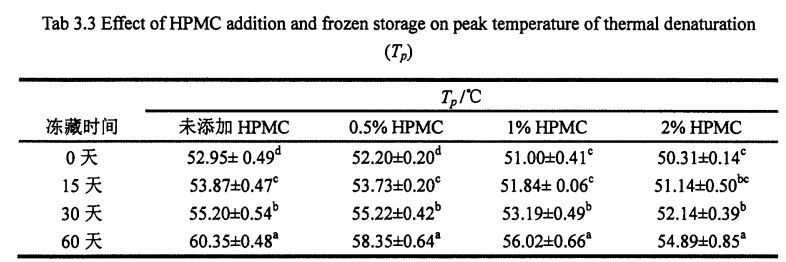
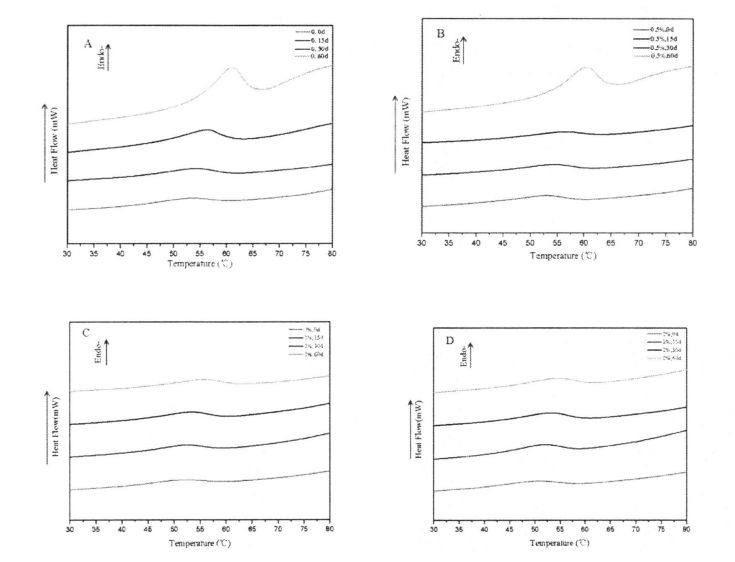
Fig 3.2 Typical DSC thermograms of gluten proteins with 0%HPMC(A);with O.5%HPMC(B); with 1%HPMC(C);with 2%HPMC(D)after different time of frozen storage,from 0d to 60d indicated from the lowest curve to the highest one in each graph. Note: A is the DSC curve of wheat gluten without adding HPMC; B is the addition of O. DSC curve of wheat gluten with 5% HPMC; C is the DSC curve of wheat gluten with 1% HPMC; D is the DSC curve of wheat gluten with 2% HPMC 3.3.3 Effects of HPMC addition amount and freezing time on free sulfhydryl content (C-SH) Intermolecular and intramolecular covalent bonds are very important for the stability of dough network structure. A disulfide bond (-SS-) is a covalent linkage formed by dehydrogenation of two free sulfhydryl groups (.SH). Glutenin ya ƙunshi glutenin da galidin, da farko na iya samar da nazarin ciki da kuma nuna bambancin ra'ayi, yayin da ƙarshen zai iya samar da haɗin gwiwar disulpular / onlmolecular bond ne. important way of cross-linking. Compared to adding 0%, O. The C-SH of 5% and 1% HPMC without freezing treatment and the C-SH of gluten after 60 days of freezing have different degrees of increase respectively. Musamman, fuska ba tare da gluten gluten C. Shin ƙara ta 3.74 "Mol / g da 1.33" Mol / g zuwa 5.33 "Mol / G. a1. (2012) found that after 120 days of frozen storage, the content of free thiol groups increased significantly [ 1071. It is worth noting that the C-SH of gluten protein was significantly lower than that of other frozen storage periods when the freezing period was 15 days, which may be attributed to the freezing shrinkage effect of gluten protein structure, which makes the More intermolecular and intramolecular disulfide bonds were locally formed in a shorter freezing time [1161. Wang, et a1. (2014) found that the C-SH of glutenin-rich proteins was also significantly increased after 15 days of freezing. Decreased [1251. However, the gluten protein supplemented with 2% HPMC did not increase significantly except for C-SH, which also decreased significantly at 15 days, with the extension of freezing time.
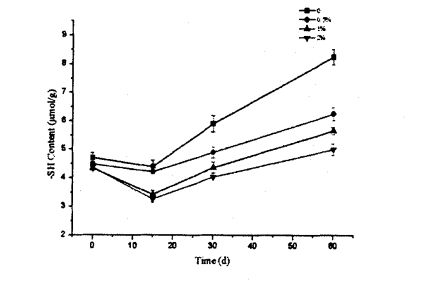
Fig 3.3 Effect of HPMC addition and frozen storage on the content of free-SH for gluten proteins As mentioned above, freezable water can form ice crystals at low temperatures and distribute in the interstices of the gluten network. Therefore, with the prolongation of freezing time, the ice crystals become larger, which squeezes the gluten protein structure more seriously, and leads to the breakage of some intermolecular and intramolecular disulfide bonds, which increases the content of free sulfhydryl groups. On the other hand, the experimental results show that HPMC can protect the disulfide bond from the extrusion damage of ice crystals, thereby inhibiting the depolymerization process of gluten protein. 3.3.4 Effects of HPMC addition amount and freezing storage time on transverse relaxation time (T2) of wet gluten mass The distribution of Transverse Relaxation Time (T2) can reflect the model and dynamic process of water migration in food materials [6]. Figure 3.4 shows the distribution of wet gluten mass at 0 and 60 days with different HPMC additions, including 4 main distribution intervals, namely 0.1.1 ms (T21), 1.10 ms (T22), 10.100 ms (dead;) and 1 00-1 000 ms (T24). Bosmans et al. (2012) sun sami irin rarraba gluten taro [1261], kuma sun ba da shawarar rarraba lokacin shakatawa da yawa, yayin da rawa na iya rarrabewar lokacin shakatawa da aka daure zuwa ga karamin adadin da aka ɗaure don gluten furotin. Bugu da kari, KongiorGos (2007) - T11¨, da "Strands" na tsarin hanyoyin Gluten preters da yawa, ruwa mai iyaka), ruwa mai iyaka), ruwa mai iyaka), ruwa mai iyaka), ruwa mai iyaka. And T23 can be attributed to the relaxation time distribution of restricted water. The T24 distribution (>100 ms) has a long relaxation time, so it characterizes free water with strong mobility. Wannan ruwa ya wanzu a cikin pores na tsarin cibiyar sadarwa, kuma akwai wani rauni capillary karfi tare da tsarin furotin gluten.
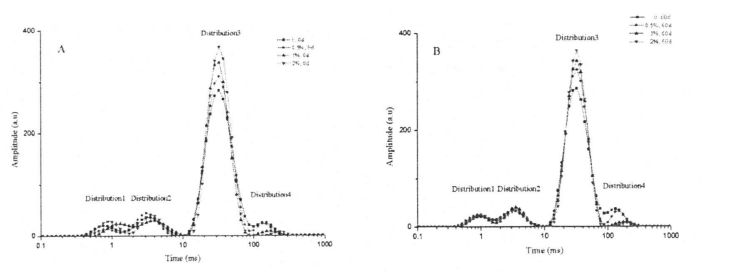
Fig 3.4 Tasiri na karin bayani da daskararre mai daskarewa akan rarraba hanyoyin shakatawa na transvere don gluten kullu
SAURARA: A da B wakiltar lokacin shakatawa (n) Rarraba muryoyin shakatawa mai laushi tare da abubuwan da suka shafi HPMC da kwanaki 60 da kwanaki 60 a cikin daskarewa ajiya, bi da bi
Comparing the wet gluten doughs with different addition amounts of HPMC stored in frozen storage for 60 days and unfrozen storage respectively, it was found that the total distribution area of T21 and T24 did not show a significant difference, indicating that the addition of HPMC did not significantly increase the relative amount of bound water. Abun ciki, wanda zai iya zama saboda gaskiyar cewa babban abubuwan ruwa na ruwa (furotin gluten tare da karamin adadin sitaci) ba a canza shi sosai ta hanyar karamin adadin HPMC. On the other hand, by comparing the distribution areas of T21 and T24 of wet gluten mass with the same amount of HPMC added for different freezing storage times, there is also no significant difference, which indicates that the bound water is relatively stable during the freezing storage process, and has a negative impact on the environment. Changes are less sensitive and less affected.
However, there were obvious differences in the height and area of T23 distribution of wet gluten mass that was not frozen and contained different HPMC additions, and with the increase of addition, the height and area of T23 distribution increased (Fig. 3.4). This change shows that HPMC can significantly increase the relative content of limited water, and it is positively correlated with the added amount within a certain range. Bugu da kari, tare da fadada lokacin daskarar daskarewa, tsawo da kuma yankin rarraba T23 Rarraba da abun ciki na hpmc iri ɗaya ya ragu zuwa digiri daban-daban. Therefore, compared with bound water, limited water showed a certain effect on freezing storage. Sensitivity. This trend suggests that the interaction between the gluten protein matrix and the confined water becomes weaker. This may be because more hydrophobic groups are exposed during freezing, which is consistent with the thermal denaturation peak temperature measurements. In particular, the height and area of the T23 distribution for the wet gluten mass with 2% HPMC addition did not show a significant difference. Wannan yana nuna cewa hpmc na iya iyakance hijirar da kuma sake fasalin ruwa, kuma na iya hana canjin jihar daga jihar da aka ƙuntatawa a lokacin daskarewa.
Bugu da kari, tsayi da yanki na rarraba T24 na rigar gluten taro tare da abubuwan da daban-daban na HPMC sun bambanta da yawa (Fig. Da aka ƙara da yawa. This is just the opposite of the Dang distribution. Sabili da haka, wannan dokar dabam tana nuna cewa hpmc tana da ruwa riƙe iyawa da kuma canza ruwa kyauta don rufe ruwa. Koyaya, bayan kwanaki 60 na daskarewa, tsayin da yanki na T24 Rarraba ya karu ga bambance-bambancen ruwa, wanda ya nuna cewa jihar T24 ta karu daga jihar da aka ƙuntata zuwa jihar da aka watsa ta hanyar daskarewa. Wannan shi ne akasin haka saboda canjin furotin furotin ya dace da lalata "Layer" a cikin tsarin gluten, wanda ya canza yanayin ruwan da aka tsare a ciki. Kodayake abun cikin ruwa mai daskarewa da DSC kuma yana ƙaruwa tare da tsawaita lokacin daskarar da kuma ƙa'idodin halaye na biyu, ruwan ɗorewa da ruwa mai ɗorewa da kuma ruwan 'yar tsana da ruwa ba daidai ba. Don tsananin gluten taro kara tare da 2% na dumbin abinci mai daskarewa, wanda babu ɗayan abubuwan da ke tattare da shi, babu ɗayan kaddarorin rukunansa da kuma huldarsa da gluten. and stable liquidity.
Fourier transform infrared spectroscopy (FT-IR) has been widely used for high-throughput determination of the secondary structure of protein samples. Ka'idojin da ke cikin sanannun sunadarai sun haɗa da sunadarai sun haɗa da, Amide II Band (1600.1500 cm-1) kuma Amide III Band (1350.1200 cm-1). Correspondingly, the amide I band the absorption peak originates from the stretching vibration of the carbonyl group (-C=O-.), the amide II band is mainly due to the bending vibration of the amino group (-NH-) [1271], and the amide III band is mainly due to the amino bending vibration and .CN-.Synchronous compound vibration in the same plane of bond Girma girgizawa, kuma yana da babban hankali ga canje-canje a tsarin sakandare [128'1291. Although the above three characteristic bands are all characteristic infrared absorption peaks of proteins, the specific In other words, the absorption intensity of amide II band is lower, so the semi-quantitative accuracy of protein secondary structure is poor; Duk da yake tsananin ɗaukar ƙarfin ni ban zama mafi girma ba, saboda haka masu bincike da yawa na masu sakandare [1301, amma ƙwanƙwarar ruwa da kuma Amide waɗanda aka mamaye su a kusan 1640 cm. 1 wavenumber (Overlapped), which in turn affects the accuracy of the results. Therefore, the interference of water limits the determination of the amide I band in protein secondary structure determination. In this experiment, in order to avoid the interference of water, the relative contents of four secondary structures of gluten protein were obtained by analyzing the amide III band. Peak position (wavenumber interval) of

Hoto na 3.5 shine hadadden abin da ke faruwa na IIIIDE III da aka kara tare da abubuwan da suka shafi HPMC na 0 kwanaki bayan da ya yi sanyi da ingancin na biyu. (2001) Amfani da shi na biyu don dacewa da kololuwar ƙwararru tare da siffofin ganawa iri ɗaya [1321]. Domin tara canje-canjen da ke cikin dangi na kowane tsarin sakandare, Tebur 3.5 ya takaita kashi dari na sakandare na furotin daban-daban da kuma wasu wurare daban-daban.
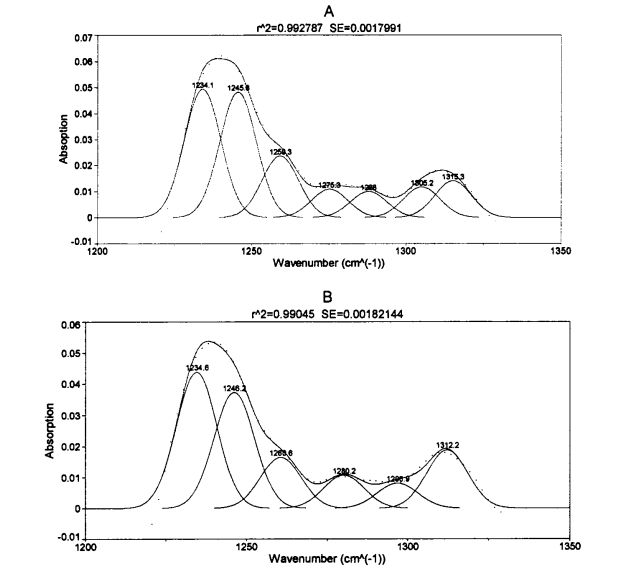
Tare da tsawaita lokacin ajiya mai daskarewa, tsarin sakandare na furotin na gluten tare da wasu daban-daban na HPMC ya canza zuwa digiri daban-daban. It can be seen that both frozen storage and addition of HPMC have an effect on the secondary structure of gluten protein. Regardless of the amount of HPMC added, B. The folded structure is the most dominant structure, accounting for about 60%. After 60 days of frozen storage, add 0%, OB Gluten of 5% and 1% HPMC. Abubuwan da ke cikin froms sun karu sosai ta 3.66%, 1.87%, bi da bi, bi da bi, da kuma kashi 1.16%, da bi da bi, wanda ya ƙaddara sakamakon sakamakon Meziani et al. (2011) [l33J]. However, there was no significant difference during frozen storage for gluten supplemented with 2% HPMC. In addition, when frozen for 0 days, with the increase of HPMC addition, p. The relative content of folds increased slightly, especially when the addition amount was 2%, p. The relative content of folds increased by 2.01%. D. The folded structure can be divided into intermolecular p. Nadawa (lalacewa ta hanyar tarawa na kwayoyin sunadarai), Antipairalell p. Nada da a layi daya p. Ana yin sauyawa guda uku, kuma yana da wuya a tantance wanda ya ci nasara a lokacin aiwatar da daskarewa
changed. Wasu masu bincike sun yarda cewa karuwa a cikin abubuwan da ke cikin dangi na tsarin B-na za su haifar da karuwa cikin tsayayye da hydrophobibcicity na Steric Conformation [41], da sauran masu bincike sun yi imani da cewa p. Yawan hadaddun a cikin tsari yana saboda wani bangare na sabon β-kantin samarwa yana tare da raunana ƙarfin tsarin hydrogen ya tabbatar [421]. β- karuwa a cikin tsari na nunawa yana nuna cewa an auna furotin ta hanyar ɗumbin zafin rana ta hanyar DSC da kuma rarraba lokacin shakatawa na denan denan nukiliya. Protein denaturation. On the other hand, added 0.5%, 1% and 2% HPMC gluten protein α-whirling. Abun da ke cikin Helix ya karu da kashi 0.95%, 4.42% da 2.03% tare da tsinkayen lokacin daskarewa, wanda ya yi daidai da Wang, et A1. (2014) found similar results [134]. 0 of gluten without added HPMC. Babu wani canji mai mahimmanci a cikin abubuwan da ke cikin dangi na Helix a lokacin da ake girka mai dafaffen daskararre, amma tare da karuwar ƙari na daskarewa don 0 kwanaki. There were significant differences in the relative content of α-whirling structures.
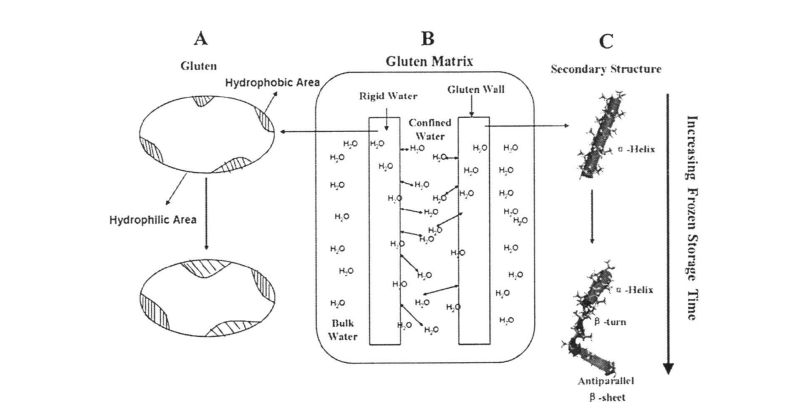
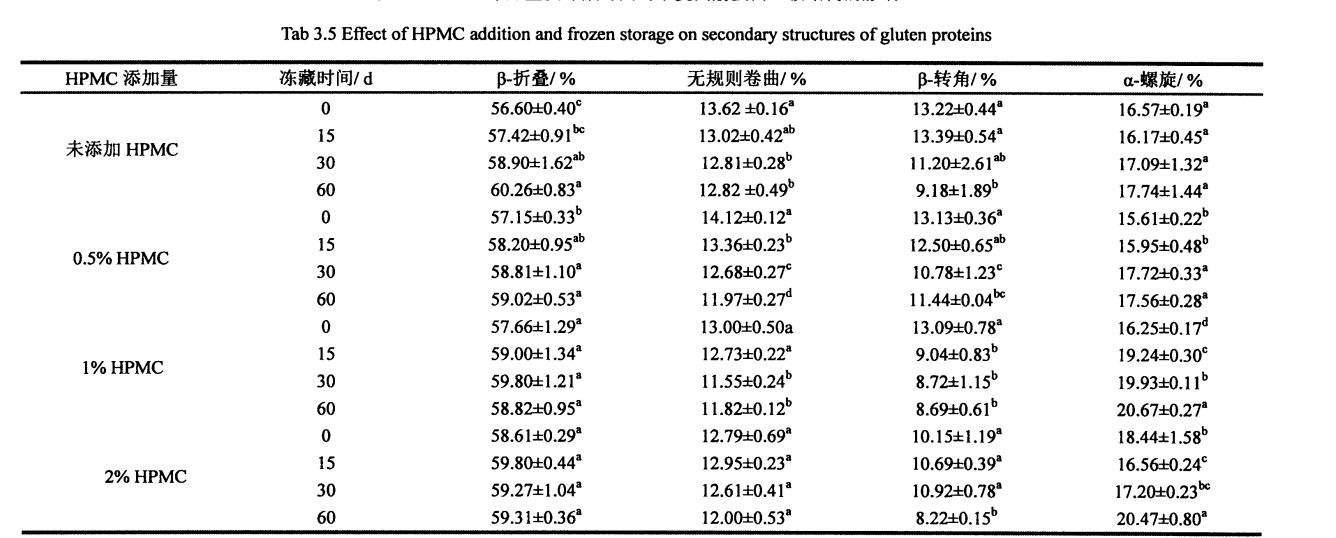
All samples with the extension of freezing time, p. The relative contents of the corners were significantly reduced. This shows that β-turn is very sensitive to freezing treatment [135. 1361], and whether HPMC is added or not has no effect. Wellner, et a1. (2005) ya ba da shawarar cewa β-sarkar sarkar furotin yana da alaƙa da tsarin yanki na Glutenin polypopeptide sarkar sarkar [37]. Except that the relative content of random coil structure of gluten protein added with 2% HPMC had no significant change in frozen storage, the other samples were significantly reduced, which may be caused by the extrusion of ice crystals. Bugu da kari, lokacin da daskararre na 0 kwanaki na α-girix, β-takarda sun bambanta da na furotin gluten ba tare da HPMC ba. Wannan na iya nuna cewa akwai hulɗa tsakanin HPMC da Gluten furotin, suna ƙirƙirar sabon haɗin hydrogen sannan ya shafi daidaita furotin; or HPMC absorbs the water in the pore cavity of the protein space structure, which deforms the protein and leads to more changes between the subunits. close. The increase of the relative content of β-sheet structure and the decrease of the relative content of β-turn and α-helix structure are consistent with the above speculation. A lokacin aiwatar da daskararru, watsar da ruwa da ƙaura da lu'ulu'u na kankara yana lalata shaidar hydrogen waɗanda ke kula da kwanciyar hankali da kuma fallasa ƙungiyoyin sunadarai. In addition, from the perspective of energy, the smaller the energy of the protein, the more stable it is. At low temperature, the self-organization behavior (folding and unfolding) of protein molecules proceeds spontaneously and leads to conformational changes.

Bayan kwanaki 60 na daskararren daskararre, ƙara 0%, O. A cikin 100% na HPMC ya karu da kashi 7%, da 2% na HPMC, 45.63%, bi da bi (tebur 3.6). In particular, the surface hydrophobicity of the gluten protein without adding HPMC after being frozen for 30 days has increased significantly (P<0.05), and it is already greater than the surface of the gluten protein with 1% and 2% HPMC added after freezing for 60 days Hydrophobicity. At the same time, after 60 days of frozen storage, the surface hydrophobicity of gluten protein added with different contents showed significant differences. Koyaya, bayan kwanaki 60 na daskararren ajiya, farfajiya hydrophobicity ta kara da 2% na ciyawar ƙasa, kuma ya kasance ƙasa da sauran darajar ƙasa ta samfurin. Wannan yana nuna cewa HPMC na iya hana maganin den lokaci na furotin furotin, wanda ya yi daidai da sakamakon ductation na ƙwayar ƙwayar ƙwayar ƙwayar ƙwayar ƙwayar ƙwayar ƙwayar ƙwayar ƙwayar ƙwayar ƙwayar ƙwayar ƙwayar ƙwayar ƙwayar ƙwayar ƙwayar ƙwayar ƙwayar ƙwayar ƙwayar ƙwayar ƙwayar ƙwayar ƙwayar ƙwayar ƙwayar ƙwayar ƙwayar ƙwayar ƙwayar ƙwayar ƙwayar ƙwayar ƙwayar ƙwayar ƙwayar ƙwayar ƙwayar ƙwayar ƙwayar ƙwayar ƙwayar ƙwayar ƙwayar ƙwayar ƙwayar ƙwayar ƙwayar ƙwayar ƙwayar ƙwayar ƙwayar ƙwayar ƙwayar ƙwayar ƙwayar ƙwayar ƙwayar ƙwayar ƙwayar ƙwayar ƙwayar ƙwayar ƙwayar ƙwayar ƙwayar ƙwayar ƙwayar ƙwayar ƙwayar ƙwayar ƙwayar ƙwayar ƙwayar ƙwayar ƙwayar ƙwayar ƙwayar ƙwayar ƙwayar ƙwayar ƙwayar ƙwayar ƙwayar ƙwayar ƙwayar ƙwayar ƙwayar ƙwayar ƙwayar ƙwayar ƙwayar ƙwayar ƙwayar ƙwayar ƙwayar ƙwayar ƙwayar ƙwayar ƙwayar ƙwayar ƙwayar ƙwayar ƙwayar ƙwayar ƙwayar ƙwayar ƙwayar ƙwayar ƙwayar ƙwayar ƙwayar ƙwayar ƙwayar ƙwayar ƙwayar ƙwayar ƙwayar ƙwayar ƙwayar ƙwayar ƙwayar ƙwayar ƙwayar ƙwayar ƙwayar ƙwayar ƙwayar ƙwayar ƙwayar ƙwayar ƙwayar ƙwayar ƙwayar ƙwayar ƙwayar ƙwayar ƙwayar ƙwayar ƙwayar ƙwayar ƙwayar ƙwayar ƙwayar ƙwayar ƙwayar ƙwayar ƙwayar ƙwayar ƙwayar ƙwayar ƙwayar ƙwayar ƙwayar ƙwayar ƙwayar ƙwayar ƙwayar ƙwayar ƙwayar ƙwayar ƙwayar ƙwayar ƙwayar ƙwayar ƙwayar ƙwayar ƙwayar ƙwayar ƙwayar ƙwayar ƙwayar ƙwayar ƙwayar ƙwayar ƙwayar ƙwayar ƙwayar ƙwayar ƙwayar ƙwayar ƙwayar ƙwayar ƙwayar ƙwayar ƙwayar ƙwayar ƙwayar ƙwayar ƙwayar ƙwayar ƙwayar ƙwayar ƙwayar ƙwayar ƙwayar ƙwayar ƙwayar ƙwayar ƙwayar ƙwayar ƙwayar ƙwayar ƙwayar ƙwayar ƙwayar ƙwayar ƙwayar ƙwayar ƙwayar ƙwayar ƙwayar ƙwayar cuta ba. This is because HPMC can inhibit the destruction of protein structure by recrystallization, and due to its hydrophilicity,
Matsakaicin tsarin hanyar sadarwa mai cike da Gluten ya ƙunshi pores da yawa don kula da gas da yisti yayin aikin tabbatar da kullu. Saboda haka, ƙarfin da kwanciyar hankali da kwanciyar hankali tsarin cibiyar sadarwa suna da muhimmanci sosai ga ingancin samfurin ƙarshe, kamar takamaiman girma, inganci, da sauransu. From a microscopic point of view, the surface morphology of the material can be observed by scanning electron microscopy, which provides a practical basis for the change of the gluten network structure during the freezing process.
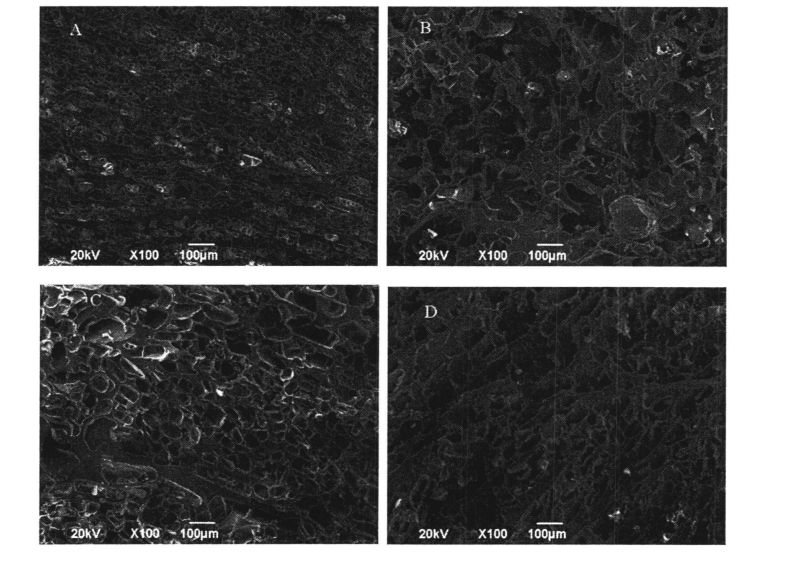
Hoto na 3.7
Karamin kimanin porongous soso-kamar halittar jiki. However, after 60 days of frozen storage, the cells in the gluten microstructure without HPMC became larger in size, irregular in shape, and unevenly distributed (Fig. 3.7, A, B), mainly due to the This is caused by the fracture of the "wall", which is consistent with the measurement results of the free thiol group content, that is, during the freezing process, the ice crystal squeezes and breaks the disulfide bond, which affects the strength and integrity of the structure. As reported by Kontogiorgos & Goff (2006) and Kontogiorgos (2007), the interstitial regions of the gluten network are squeezed due to freeze-shrinkage, resulting in structural disruption [138. 1391]. Bugu da kari, saboda fadakarwa da kwanciyar hankali, da dan kadan mai santsi an samar da shi a cikin spongy mai ban sha'awa a cikin mitan mai sanyi, saboda an samar da faduwar disulfofie. The gluten structure was not severely damaged for a shorter time, which is consistent with Wang, et a1. (2014) observed similar phenomena [134]. At the same time, the destruction of the gluten microstructure leads to freer water migration and redistribution, which is consistent with the results of low-field time-domain nuclear magnetic resonance (TD-NMR) measurements. Some studies [140, 105] reported that after several freeze-thaw cycles, the gelatinization of rice starch and the structural strength of the dough became weaker, and the water mobility became higher. Ban da haka, bayan kwanaki 60 na mai daskararren daskararre, da microsructure na gluten tare da 2% HPMC da ƙari na yau da kullun fiye da gluten (Fig. 3.7, B, D). This further indicates that HPMC can effectively inhibit the destruction of gluten structure by recrystallization.
This experiment investigated the rheology of wet gluten dough and gluten protein by adding HPMC with different contents (0%, 0.5%, 1% and 2%) during freezing storage (0, 15, 30 and 60 days). properties, thermodynamic properties, and effects of physicochemical properties. The study found that the change and redistribution of water state during the freezing storage process significantly increased the freezable water content in the wet gluten system, which led to the destruction of the gluten structure due to the formation and growth of ice crystals, and ultimately caused the processing properties of the dough to be different. Deterioration of product quality. The results of frequency scanning showed that the elastic modulus and viscous modulus of the wet gluten mass without adding HPMC decreased significantly during the freezing storage process, and the scanning electron microscope showed that its microstructure was damaged. An kara da abun cikin subfhyl na kungiyar 'yancin gaske, kuma an fi karfin kungiyar ta hydrophobic, wanda ya sanya munanan zafin jiki da kuma surfallen shinkafa da kuma surface shererophobicity na Gluten furotin muhimmanci. Koyaya, sakamakon gwaji ya nuna cewa Bugu da ƙari na I-iPMC na iya hana canje-canje a cikin tsari da kuma kayan furotin mai narkewa ne da ƙari na HPMC. Wannan saboda HPMC na iya rage motsi da ruwa mai narkewa, da kuma hana tsarin recorstonlory kuma kiyaye tsarin sake amfani da gluten da spatial hade da kwanciyar hankali. This shows that the addition of HPMC can effectively maintain the integrity of the frozen dough structure, thereby ensuring product quality.
Starch is a chain polysaccharide with glucose as the monomer. key) two types. From a microscopic point of view, starch is usually granular, and the particle size of wheat starch is mainly distributed in two ranges of 2-10 pro (B starch) and 25-35 pm (A starch). From the perspective of crystal structure, starch granules include crystalline regions and amorphous regions (je, non-crystalline regions), and the crystal forms are further divided into A, B, and C types (it becomes V-type after complete gelatinization). Generally, the crystalline region consists of amylopectin and the amorphous region consists mainly of amylose. Wannan saboda, additionari ga Car sarkar (babban sarkar), Amyletectoc kuma yana da sarƙoƙi na B (wanda ya sa amylopeectin B (Carbon Sarkar) da C (Carbon-Carbon-kamar "a cikin sitaci. The shape of the crystallite bundle is arranged in a certain way to form a crystal.
Starch is one of the main components of flour, and its content is as high as about 75% (dry basis). A lokaci guda, a matsayin carbohyd warbi a cikin hatsi, sitaci shima babban kayan tushen makamashi a abinci. A cikin tsarin kullu, an rarraba sitaci mafi yawa kuma a haɗe da tsarin hanyar sadarwa na furotin. A yayin sarrafawa da ajiya, star sau da yawa ana yin gelatinization da kuma gwaje-gwaje na tsufa.
Daga cikin su, sitaci gelatination yana nufin aiwatarwa a cikin abin da sitaci granulolin da aka lalata a hankali kuma yana kan cikin tsarin tare da babban abun ciki kuma a karkashin yanayin dumama. It can be roughly divided into three main processes. 1) Reversible water absorption stage; Kafin kai yawan zafin jiki na farko, sitaci granules a cikin sitacifar dakatarwar su ba canzawa, da tsarin ciki da tsarin ciki ba sa canzawa. Only very little soluble starch is dispersed in the water and can be restored to its original state. 2) The irreversible water absorption stage; Kamar yadda zafin jiki ya karu, ruwa ya shiga rata tsakanin sitaci cryallite daure, wanda ba a iya fadada sitaci sau da yawa ba, kuma bakandaya yana haifar da sitaci sau da yawa, da kuma shaidar hydrogen tsakanin mahimmin kwayoyin sun karye. It becomes stretched and the crystals disappear. A lokaci guda phening na sitadtringen na sitaci, wato, da Maltese ya lura a karkashin milipope na ruwa, yana farawa, yana farawa, da zazzabi a wannan lokacin ana kiranta yawan zazzabi na sitaci. 3) Starch granule disintegration stage; Maɓallin sitaci gaba ɗaya shigar da tsarin mafita don samar da sitaci manna (pastte / sitaci gel), da kuma zazzabi na farko ana kiranta Enitan Saro Gelaton gaba ɗaya, kuma zazzabi na farko ana kiranta Enitan Saro Gelaton gaba ɗaya, kuma zazzabi na farko ana kiranta Enit Gelatination zazzabi, da kuma zazzabi a wannan lokacin ana kiranta Ening Copization zazzabi, da kuma zazzabi a wannan lokacin ana kiranta cikakke sitaci gel na zazzabi, da kuma zazzabi na gel) kuma ana kiranta cikakken sitaci gel) shi ne kuma ana kiranta Entar Gelatination, 141]. Lokacin da kullu ke dafa shi, gelatination na sitaci yana haifar da abinci tare da kayan aikinta na musamman, dandano, ɗanɗano, launi, da kuma sarrafa halaye.
Gabaɗaya, sitaci gelatinization ya shafa ta hanyar tushen da kuma yanayin rarrabuwa da kuma daidaitawa, ƙidaya na zamani, zazzabi, danshi ciki, da sauransu) [142-150]. Sabili da haka, lokacin da tsarin sitaci (a cikin ƙwayar saman jiki, tsarin lu'ulu'u, da sauransu) an canza, kayan gelatinigais, narkewar sitaci za a shafa bisa gunduma.
Nazarin da yawa sun nuna cewa gel na sitaci na sitaci manna ragewa, yana da sauƙin tsufa a ƙarƙashin yanayin yanayin daskarewa, kamar kuma cente, et A1. (2005) studied the effect of freezing temperature on the quality of potato starch puree; Ferrero, et a1. (1993) investigated the effects of freezing rate and different types of additives on the properties of wheat and corn starch pastes [151-156]. Koyaya, akwai wasu rahotanni kaɗan akan tasirin daskararre akan tsari da kaddarorin sitaci granules (asalin ƙasar sitaci), wanda ke buƙatar ƙara bincika. Frozen dough (excluding pre-cooked frozen dough) is in the form of ungelatinized granules under the condition of frozen storage. Saboda haka, nazarin tsarin da tsarin asalin 'yan asalin ƙasa ta hanyar ƙara HPMC yana da wani tasiri akan inganta kaddarorin sarrafa daskarewa. significance.
Mai masana'anta
Aure 1 g na sitaci, ƙara 9 ml na ruwa distilled, cikakken girgiza da Mix don shirya tsawar 10% (w / w) sitaci. Sannan sanya maganin samfurin. 18 ℃ refrigerator, frozen storage for 0, 15 d, 30 d, 60 d, of which 0 day is the fresh control. Add 0.5%, 1%, 2% (w/w) HPMC instead of the corresponding quality starch to prepare samples with different addition amounts, and the rest of the treatment methods remain unchanged.
Auki samfurori da aka ambata a sama da aka ambata tare da lokacin da ya dace da ƙari, daidaitawa a 4 ° C don zazzabi har sai sun matsa zuwa zazzabi gaba ɗaya har sai sun narke gaba ɗaya.
Zana 1.5 ml na mafita samfurin bayani kuma ƙara a tsakiyar samfurin samfurin na rheerometer, kuma samun lokaci (mai s) da zazzabi (pac c) kamar yadda sitaci gelatination na umarnin. A cewar GB / t 14490.2, [158], yawan halayen gelatinization-gelatinization peak (ang), mafi ƙarancin danko (ratio) an samo shi (rati) da ƙimar ƙimar (rare). Value, BV) and regeneration value (Setback Value, SV), wherein, decay value = peak viscosity - minimum viscosity; setback value = final viscosity - minimum viscosity. Each sample was repeated three times.
Filin da aka ambata a sama ya mamaye gwajin kwarara mai gudana, bisa ga Achayhakar [1591, an saita siginar suban-minti 10, da kuma garkuwar scan na biyu, 0.1 s daya. 100S~, 2) 100s~. 0.1 S ~, ana tattara bayanan a yanayin logarithmic, da maki 10 na karfi (iear kudi) ne a matsayin ABSCISHORORSOWORS na ba da umarnin. Yi amfani da asalin 8.0 don yin dacewa da daidaituwa na wannan abin da ya dace kuma, da kuma daidaitawa ta hanyar da aka saba da ita (Fasta ta kwarara, girma).
Aauki 2.5 g na amyloid kuma Mix shi da distilled ruwa a cikin wani rabo na 1: 2 don yin madara sitaci. Freeze at 18°C for 15 d, 30 d, and 60 d. Add 0.5, 1, 2% HPMC (w/w) to replace starch of the same quality, and other preparation methods remain unchanged. After the freezing treatment is completed, take it out, equilibrate at 4 °C for 4 h, and then thaw at room temperature until it is tested.
A layer of petrolatum was lightly applied to the edge of the starch gel obtained above to avoid water loss during subsequent experiments. Magana game da hanyar Abebe & Ronya [1601], an yi wani yanki na Oscilatory da aka yi shi ne na 0.01-100%, da mitar ta fara 1 Hz C na 10 min.
Bayan haka, share da oscilic mita, saita da iri mai iri (iri) zuwa 0.1% (bisa ga sakamakon da iri ya shawo kan batun O. 1 zuwa 10 hz. Each sample was repeated three times.
Dukkanin gwaje-gwajen an maimaita su aƙalla sau uku sai dai an ƙayyade sakamakon gwaji a matsayin ma'ana da daidaitattun halaye. SPSS Statistic 19 was used for analysis of variance (Analysis of Variance, ANOVA) with a significance level of 0.05; correlation charts were drawn using Origin 8.0.
A cewar GB 500931010, GB / T 5009.9.2008, GB 500940.010 (78-S0), danshi na asali, amylosopecin da ash abin da aka ƙaddara. The results are shown in Table 4. 1 shown.

The starch suspension with a certain concentration is heated at a certain heating rate to make the starch gelatinized. Bayan fara gelatintize, ruwa mai bushewa sannu a hankali ya zama abin mamaki saboda fadada sitaci, kuma karen vicelonity yana ƙaruwa gaba. Subsequently, the starch granules rupture and the viscosity decreases. When the paste is cooled at a certain cooling rate, the paste will gel, and the viscosity value will further increase. The viscosity value when it is cooled to 50 °C is the final viscosity value (Figure 4.1).
Tebur 4.2 ya lissafa tasirin alamun alamomi masu mahimmanci na sitaci na halaye, da ƙima da ƙimar gyarawa, mafi ƙarancin danko, a lokacin daskarewa a kan sitaci manna. effects of chemical properties. The experimental results show that the peak viscosity, the minimum viscosity and the final viscosity of starch without frozen storage increased significantly with the increase of HPMC addition, while the decay value and recovery value decreased significantly. Specifically, the peak viscosity gradually increased from 727.66+90.70 CP (without adding HPMC) to 758.51+48.12 CP (adding 0.5% HPMC), 809.754-56.59 CP (adding 1 %HPMC), and 946.64+9.63 CP (adding 2% HPMC); the minimum viscosity was increased from 391.02+18.97 CP (blank not adding) to 454.95+36.90 (adding O .5% HPMC), 485.56+54.0.5 (add 1% HPMC) and 553.03+55.57 CP (add 2% HPMC); the final viscosity is from 794.62.412.84 CP ( Without adding HPMC) increased to 882.24±22.40 CP (adding 0.5% HPMC), 846.04+12.66 CP (adding 1% HPMC) and 910.884-34.57 CP (adding 2 %HPMC); Koyaya, ƙimar ƙimar sannu a hankali ya ragu daga 336.644-71.73 CP (ƙara 0,54 cp (ƙara
With 1% HPMC) and 393.614-45.94 CP (with 2% HPMC), the retrogradation value decreased from 403.60+6.13 CP (without HPMC) to 427.29+14.50 CP, respectively (0.5% HPMC added), 360.484-41.39 CP (15 HPMC added) and 357.85+21.00 CP (2% HPMC added). Wannan kuma ƙari na hydrocolloids kamar Xanthan gum da ASDHANANANIKE Samu da ACHALHANIKAKAN & SPHANTHARIJA (2008) da Huang (2009) na iya ƙara yawan gelatiniyanci yayin rage darajar retrgradation na sitaci. Wannan na iya zama galibi saboda HPMC suna aiki a matsayin nau'in Colloid na Hydrophilic, da kuma ƙari na HPMC ta haɓaka gelatrovic fiye da sarkar ta hydrophilic fiye da sitaci granuloles a ɗakin zazzabi. Bugu da kari, kewayon zafin jiki na gelateral gelateral (tsari na thermogation) na HPMC zai fi girma sosai har zuwa mai takaici saboda rushewar sitaci. Therefore, the minimum viscosity and final viscosity of starch gelatinization increased gradually with the increase of HPMC content.

Hankawar Steather ba tare da ƙara hpmc ba daga 794.62 ± 12.84 cp (daskararre) zuwa 1413.15 ± 45.59 CP 45.59 CP 65.59 CP 65.59 CP 65.59 CP The peak viscosity of starch suspension increased from 882.24 ± 22.40 CP (frozen storage for 0 days) to 1322.86 ± 36.23 CP (frozen storage for 60 days); the peak viscosity of starch suspension added with 1% HPMC The viscosity increased from 846.04 ± 12.66 CP (frozen storage 0 days) to 1291.94 ± 88.57 CP (frozen storage for 60 days); and the gelatinization peak viscosity of starch suspension added with 2% HPMC increased from 91 0.88 ± 34.57 CP
(Frozen storage for 0 days) increased to 1198.09 ± 41.15 CP (frozen storage for 60 days). Correspondingly, the attenuation value of starch suspension without adding HPMC increased from 336.64 ± 71.73 CP (frozen storage for 0 days) to 1027.67 ± 38.72 CP (frozen storage for 60 days); Dingara 0.5 ƙimar ƙimar sitaci tare da% HPMC ta karu daga 303.56 ± 25.22 cp (daskararre) zuwa 833.9 starch suspension with 1% HPMC added The attenuation value of the liquid was increased from 324.19 ± 2.54 CP (freezing for 0 days) to 672.71 ± 10.96 CP (freezing for 60 days); while adding 2% HPMC,the attenuation value of the starch suspension increased from 393.61 ± 45.94 CP (freezing for 0 days) to 557.64 ± 73.77 CP (freezing for 60 days); while the starch suspension without HPMC added The retrogradation value increased from 403.60 ± 6.13 C
P (frozen storage for 0 days) to 856.38 ± 16.20 CP (frozen storage for 60 days); Darajar retroradation na sitaci mai kara da 0.5% hpmc ya karu daga 427% (daskararre) karuwa zuwa 740.99 299 CP 35.99 CP 35.99 CP the retrogradation value of starch suspension added with 1% HPMC increased from 360.48±41. 39 CP (frozen storage for 0 days) increased to 666.46 ± 21.40 CP (frozen storage for 60 days); Duk da yake darajar retogradation na wasan kwaikwayo ya kara da 2% na hpmc ya karu daga 357.85 ± 21.00 CP (mai sanyi ajiya na kwanaki 60). 0 days) increased to 515.51 ± 20.86 CP (60 days frozen).

Tasirin karfi na karfi a kan sananniyar danko (Shear danko) wanda ya sa gwajin kwarara da kuma kayan aikin da aka nuna daidai. Table 4.3 lists the equation parameters obtained by nonlinear fitting, that is, the consistency coefficient K and the flow characteristic index D, as well as the influence of the addition amount of HPMC and the freezing storage time on the above parameters K gate.


It can be seen from Table 4.3 that all the flow characteristic indices, 2, are less than 1. Therefore, starch paste (whether HPMC is added or whether it is frozen or not) belongs to Pseudoplastic Fluid, and all show shearing Thinning phenomenon (as the shear rate increases, the shear viscosity of the fluid decreases). In addition, the shear rate scans ranged from 0.1 s, respectively. 1 increased to 100 s ~, and then decreased from 100 sd to O. The rheological curves obtained at 1 sd do not completely overlap, and the fitting results of K, s are also different, so the starch paste is a thixotropic pseudoplastic fluid (whether HPMC is added or whether it is frozen or not). Koyaya, a ƙarƙashin lokacin daskarewa guda, tare da karuwar HPMC, banbanci tsakanin abubuwan da suka dace na K n n n n dabi'un HPMC yana nuna tsarin mashin hankali a ƙarƙashin tsananin damuwa. It remains relatively stable under the action and reduces the "thixotropic ring"
(Thixotropic Loop) area, which is similar to Temsiripong, et a1. (2005) reported the same conclusion [167]. Wannan na iya zama galibi saboda HPMC na iya samar da hanyar haɗin gwiwar masu haɗin kai tare da sarkar sitacid (galibin sarƙa), waɗanda aka ɗaure su a ƙarƙashin aikin shearing karfi. , don kula da kwanciyar hankali da daidaitaccen tsari (Hoto 4.2, Churve tare da Shear Matsakaici a matsayin ABSCSsa da kuma karfi.
Koyaya, tare da tsayar da lokacin ajiya na daskarewa, da dabi'un K kuma n ± PA 0 2.421 PAHY (kara da kwanaki 60), ya karu daga 65.683 pA n (ƙara 1% na HPMC, 0 kwana) zuwa 56.538 ± 1.378 PAHA (1% HPMC, kwanaki 60)))) 0.277 ± 0.011 (without adding HPMC, 0 days) rose to O. 334±0.014 (no addition, 60 days), increased from 0.310±0.009 (0.5% HPMC added, 0 day) to 0.336±0.014 (0.5% HPMC added, 60 days), from 0.323 ± 0.013 (add 1% HPMC, 0 days) zuwa 0.340 ± 0.013 (ƙara 1% hpmc, kwanaki 6%) 2.431 (ƙara 1% na HPMC, kwanaki 6%). By kwatanta, ana iya gano cewa tare da karuwar adadin HPMC, Canjin Kasar Knaring yana iya ɗaukar nauyin ƙarfin hali, wanda ya yi daidai da yanayin ma'aunin sitaci. daidaito.
The dynamic frequency sweep can effectively reflect the viscoelasticity of the material, and for starch paste, this can be used to characterize its gel strength (Gel Strength). Hoto 4.3 yana nuna canje-canje na ajiya / m modulus (G ') da asarar modulus (g ") na sitaci maɗaukaki a ƙarƙashin yanayin sitacid ƙari da lokacin daskarewa.

Tsarin sitaci na sitaci yana tare da rushewar sitaci na sitaci, boarfin yankin crystalline don samar da gel tare da karfin gel tare da wani karfi na. As shown in Figure 4.3, for starch without frozen storage, with the increase of HPMC addition, the G' of starch decreased significantly, while G" had no significant difference, and tan 6 increased (Liquid. 1ike), which shows that during the gelatinization process, HPMC interacts with starch, and due to the water retention of HPMC, the addition of HPMC reduces the water loss of starch during the gelatinization process. At the same time, Chaisawang & Suphantharika (2005) found that, adding guar gum and xanthan gum to tapioca starch, the G' of the starch paste also decreased [170]. In addition, with the extension of the freezing storage time, the G' of starch gelatinized decreased to different degrees. This is mainly because during the frozen storage process of starch, the amylose in the amorphous region na sitaci Granules ya rabu don samar da sitaci mai lalacewa (sitaci mai lalacewa), wanda ke rage digiri na haɗin gwiwar mai haɗin gwiwa bayan da aka haɗa da mahaɗan hanyar haɗin kai bayan haɗin haɗi bayan haɗin haɗin gwiwa. Kwanciyar hankali da daidaitawa na lu'ulu'u na lu'ulu'u ne na "Mulles" (Tsarin Motocrystalline) a cikin sitaci Glastallization sarkar Sarkar Startular, da kuma Matsakaicin Santa Sarkar (ƙwayoyin sarkar), kuma finally caused the gel strength of starch to decline. However, with the increase of HPMC addition, the decreasing trend of G' was suppressed, and this effect was positively correlated with the addition of HPMC. This indicated that the addition of HPMC could effectively inhibit the effect of ice crystals on the structure and properties of starch under frozen storage conditions.
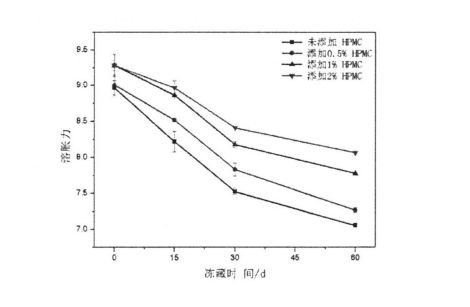
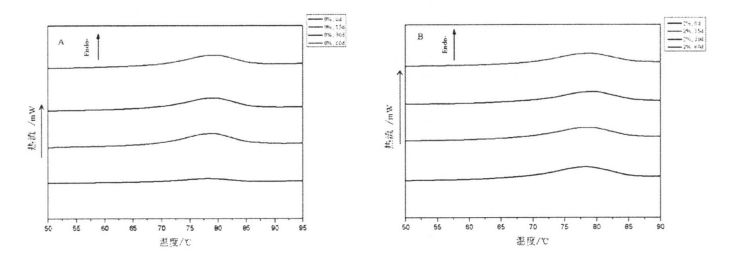
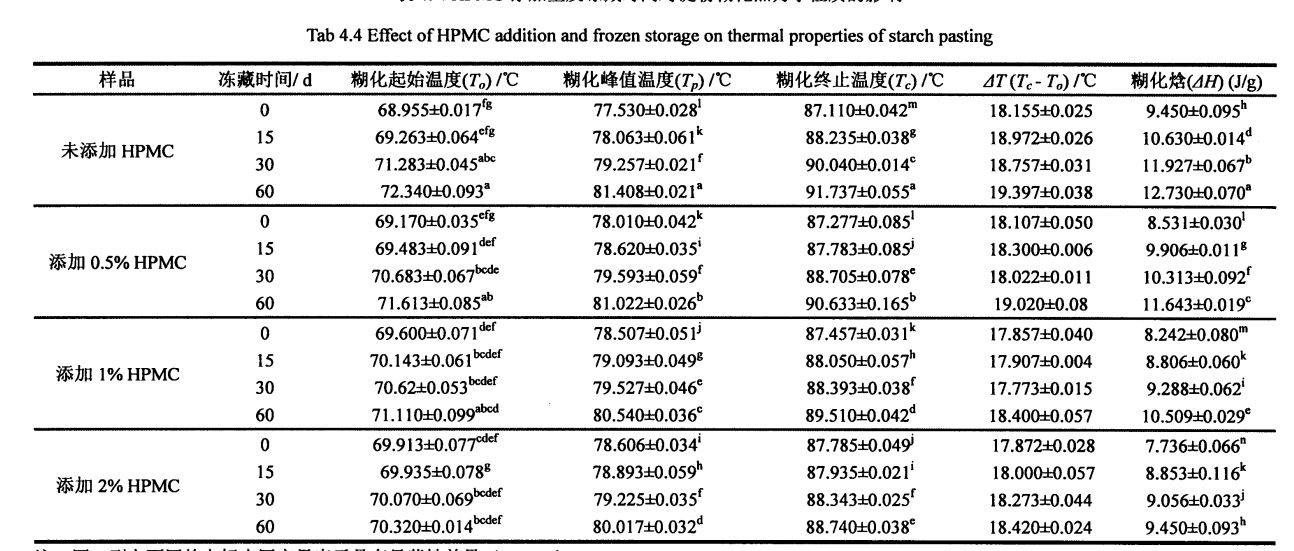
As shown in Table 4.4, for fresh amyloid, with the increase of HPMC addition, starch L has no significant difference, but increases significantly, from 77.530 ± 0.028 (without adding HPMC) to 78.010 ± 0.042 (add 0.5% HPMC), 78.507 ± 0.051 (add 1% HPMC), and 78.606 ± 0.034 (add 2% HPMC), amma 4H ne mai mahimmanci raguwa, daga 9.450 ± 0,425 (ƙara 1% hpmc) da 7,42a: 0.736 ± hpmc) da 7 .736 ± HPMC). This is similar to Zhou, et a1. (2008) An gano cewa ƙara mai amfani da ruwa mai ruwa ya rage entalinpy ental kuma ya karu ga sitaci gelatination peak zazzabi [172]. This is mainly because HPMC has better hydrophilicity and is easier to combine with water than starch. At the same time, due to the large temperature range of the thermally accelerated gelation process of HPMC, the addition of HPMC increases the peak gelatinization temperature of starch, while the gelatinization Enthalpy decreases.
On the other hand, starch gelatinization To, T p, Tc, △T and △Hall increased with the extension of freezing time. Musamman, sitaci gelatination tare da 1% ko 2% na HPMC bai kara da muhimmanci zuwa kwanaki 60.340 (mai sanyi ba), kuma daga 6,.353 (mai sanyi 71.613 ± 0.085 (frozen storage for 0 days) 60 days); after 60 days of frozen storage, the growth rate of starch gelatinization decreased with the increase of HPMC addition, such as starch without HPMC added from 77.530 ± 0.028 (frozen storage for 0 days) to 81.028. 408 ± 0.021 (frozen storage for 60 days), while the starch added with 2% HPMC increased from 78.606 ± 0.034 (frozen storage for 0 days) to 80.017 ± 0.032 (frozen storage for 60 days). days); Bugu da kari, δh kuma ya nuna mulkin canji ɗaya, wanda ya karu daga 9.450 ± 0.050 (babu ƙari (aƙalla 0.750 (babu ƙari) 0.050 (Babu ƙari (60), bi da kwanaki 60), bi da kwanaki 60), bi da kwanaki 60). 531 ± 0.030 (add 0.5%, 0 days) to 11.643 ± 0.019 (add 0.5%, 60 days), from 8.242 ± 0.080 (add 1%, 0 days) to 10.509 ± 0.029 (add 1%, 60 days), and from 7.736 ± O. 066 (2% addition, 0 days) rose to 9.450 ± 0.093 (2% addition, 60 days). Babban dalilan canje-canje da aka ambata a sama a cikin kayan aikin thermodynamic a lokacin da aka lalata daskararru a lokacin da yankin ya lalace. The coexistence of the two increases the relative crystallinity of starch, which in turn leads to an increase in thermodynamic indexes such as starch gelatinization peak temperature and gelatinization enthalpy. Koyaya, ta hanyar kwatantawa, ana iya gano cewa a karkashin lokaci na daskarewa lokaci, tare da karuwar HPMC getinationzation, t p, Δt da Δh sannu-sannu ya ragu. Ana iya ganin cewa Bugu da kari na HPMC na iya riƙe mahimmancin dangi da sitaci crarstal Crystal Crystal Crystal Crystal Crymodstamic Properties na sitaci gelatinamic na sitaci gelatinamic.
Figure 4.6. Kamar yadda aka nuna a cikin, matsayi na sitaci crystallization kololuka suna da karfe 170, 190, 190, 190, 190 ,, bi da bi da daskarewa da ko kara hpmc. This shows that, as an intrinsic property of wheat starch crystallization, the crystalline form remains stable.
Koyaya, tare da tsayarwar daskarewa lokacin, dangi na sitestall, 0 .42 (ba tare da HPMC ba, da bizuwa, bi da bi). Kwanaki 60), kuma ya ƙaru daga 25.75 + 0.21 (2% HPMC aka ƙara, 0 6% HPMAC, 1% Kwanaki (Hoto 4.b 4.6.b), wannan da Ta1. (2016), the change rules of the measurement results are consistent [173-174]. Theara yawan dangi crystality ne galibi lalacewa ta hanyar lalata wani amorphous yankin da karuwa a cikin crystalline na yankin Crystalline. In addition, consistent with the conclusion of the changes in the thermodynamic properties of starch gelatinization, the addition of HPMC reduced the degree of relative crystallinity increase, which indicated that during the freezing process, HPMC could effectively inhibit the structural damage of starch by ice crystals and maintain the Its structure and properties are relatively stable.
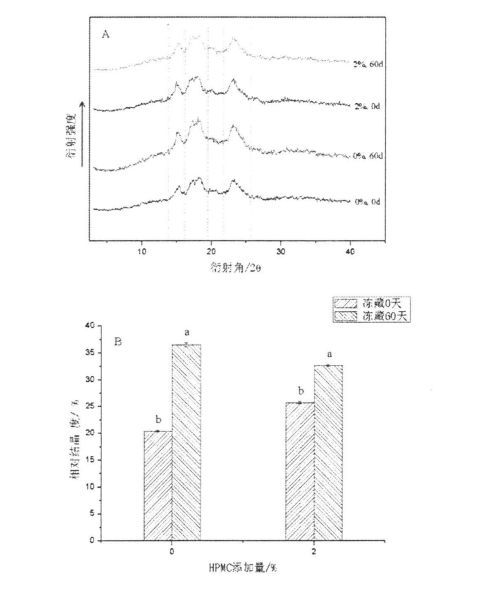
Starch is the most abundant dry matter in dough, which, after gelatinization, adds unique qualities (specific volume, texture, sensory, flavor, etc.) to the dough product. Since the change of starch structure will affect its gelatinization characteristics, which will also affect the quality of flour products, in this experiment, the gelatinization characteristics, flowability and flowability of starch after frozen storage were investigated by examining starch suspensions with different contents of HPMC added. Canje-canje a cikin kaddarorin rheological, an yi amfani da kayan aikin thermodynamic da tsarin crystal don kimanta tasirin kariya na HPMC game da Pecnul Granule State da kuma Kasuwanci mai dangantaka. Sakamakon gwaji ya nuna cewa bayan kwanaki 60 na drizincization (ganyayyaki gelathancization (ƙwararrun ƙwararru, ƙimar ƙimar ƙwayar sitaci da kuma karuwar yanayin sitaci da sitaci da sitaci. The gelatinization enthalpy increased, while the gel strength of starch paste decreased significantly; however, especially the starch suspension added with 2% HPMC, the relative crystallinity increase and starch damage degree after freezing were lower than those in the control group Therefore, the addition of HPMC reduces the degree of changes in gelatinization characteristics, gelatinization enthalpy, and gel strength, which indicates that the addition of HPMC keeps the starch structure and its gelatinization properties relatively stable.
Yisti shine microorganism na Unicellulotic Eukarganis, da sel sel, mitochondria, da dai sauransu, da nau'in abinci mai gina jiki ne na tushen microorganism. Under anaerobic conditions, it produces alcohol and energy, while under aerobic conditions it metabolizes to produce carbon dioxide, water and energy.
Yeast has a wide range of applications in fermented flour products (sourdough is obtained by natural fermentation, mainly lactic acid bacteria), it can use the hydrolyzed product of starch in the dough - glucose or maltose as a carbon source, under aerobic conditions, using Substances produce carbon dioxide and water after respiration. A carbon dioxide samar na iya yin kullu sako-sako da kullu sako-sako da kullu sako-sako da kullu sako-sako da kullu sako-sako da kullu sako-sako da kullu. A lokaci guda, da fermentation na yisti da kuma rawar da ta kasance a matsayin zurfafa ba kawai zai iya inganta darajar kayan abinci na samfurin ba, har ma yana haɓaka ƙimar halayen samfuran. Therefore, the survival rate and fermentation activity of yeast have an important impact on the quality of the final product (specific volume, texture, and flavor, etc.) [175].
In the case of frozen storage, yeast will be affected by environmental stress and affect its viability. When the freezing rate is too high, the water in the system will rapidly crystallize and increase the external osmotic pressure of the yeast, thereby causing the cells to lose water; when the freezing rate is too high. If it is too low, the ice crystals will be too large and the yeast will be squeezed and the cell wall will be damaged; both will reduce the survival rate of the yeast and its fermentation activity. Bugu da kari, da yawa nazarin sun gano cewa bayan kwayoyin yisti suna lalata saboda daskarewa, wanda kuma zai rage raguwar raguwar kayan gluten, wanda zai rage raguwar raguwar kayan gluten, wanda zai rage a cikin ingancin kayayyakin Gluten, 176-177].
Mai masana'anta
Weigh 3 g of active dry yeast, add it to a sterilized 50 mL centrifuge tube under aseptic conditions, and then add 27 mL of 9% (w/V) sterile saline to it, shake it up, and prepare 10% (w/w) yeast broth. Then, quickly move to. Store in a refrigerator at 18°C. After 15 d, 30 d, and 60 d of frozen storage, the samples were taken out for testing. Ara 0.5%, 1%, 2% HPMC (W / W) don maye gurbin adadin da ya dace da Yarinya Yuro. In particular, after the HPMC is weighed, it must be irradiated under an ultraviolet lamp for 30 minutes for sterilization and disinfection.
See Meziani, et a1. (2012)'s experimental method [17 cited, with slight modifications. Aure 5 g na daskararre kullu cikin 50 ml launi bututun mai, sannan a sanya shi a ƙasan bututun, da kuma sanya shi a ƙasan bututun, kuma infara miji na yau da kullun (suna riƙe da lambobi biyu bayan matakin dillali). For samples with uneven upper ends after proofing, select 3 or 4 points at equal intervals to measure their corresponding heights (for example, each 900), and the measured height values were averaged. Each sample was paralleled three times.
Aure 1 g da kullu, ƙara shi zuwa bututun gwaji tare da 9 ml na siyar da aka al'ada, sai girgiza shi a cikin jerin gungun taro har zuwa 10'1. Draw 1 mL of dilution from each of the above tubes, add it to the center of the 3M yeast rapid count test piece (with strain selectivity), and place the above test piece in a 25°C incubator according to the operating requirements and culture conditions specified by 3M. 5 D, cire bayan karshen al'adar, da farko ku lura da halin mallaka na mallaka don sanin ko ya yi bincike game da kuskuren yisti, sannan kuma a kirga Microscopically [179]. Each sample was repeated three times.
5.3 sakamakon da tattaunawa
Hasken hangen nesa na kullu galibi ana shafar shi ta hanyar tasirin tasirin ci gaba na yi da ƙarfi. Daga cikin su, aikin cin abinci na yi zai shafi ikon da ke tattare da samar da iskar gas, da adadin gas na yisti ya kayyade ingancin samfuran gari na fure, gami da takamaiman girma da rubutu. The fermentation activity of yeast is mainly affected by external factors (such as changes in nutrients such as carbon and nitrogen sources, temperature, pH, etc.) and internal factors (growth cycle, activity of metabolic enzyme systems, etc.).

Game da ajiya mai daskararre, tun da daskararren ruwa a cikin tsarin kullu ya canza, don haka cewa abubuwan da aka yisti na yisti ne. Lokacin da aka saukar da zazzabi ko a kiyaye shi a ƙarancin lu'ulu'u na dogon lokaci, wanda zai haifar da halakar da sel, kamar sakin rage halittar - glutathe, ko ma ya mutu. A lokaci guda, yisti karkashin damuwa damuwa, za a rage ayyukan rayuwa, kuma za'a samar da wasu spores, wanda zai rage ayyukan samar da gas na yisti.
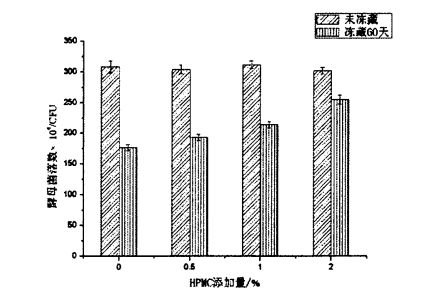
Ana iya ganin shi daga Hoto na 5.2 cewa babu wani bambanci mai mahimmanci a yawan ƙasashe a cikin samfurori tare da abin da ke cikin HPMC da aka ƙara ba tare da magani na daskarewa ba. This is similar to the result determined by Heitmann, Zannini, & Arendt (2015) [180]. However, after 60 days of freezing, the number of yeast colonies decreased significantly, from 3.08x106 CFU to 1.76x106 CFU (without adding HPMC); from 3.04x106 CFU to 193x106 CFU (adding 0.5% HPMC); reduced from 3.12x106 CFU to 2.14x106 CFU (added 1% HPMC); reduced from 3.02x106 CFU to 2.55x106 CFU (added 2% HPMC). By kwatanta, ana iya gano cewa damuwar tsabtace daskararren wurin shakatawa ta haifar da rage lambar yisti, amma tare da karuwar HPMC, amma tare da karuwar HPMC, digiri na rage yawan yankin ya ragu. This indicates that HPMC can better protect yeast under freezing conditions. Hanyar kariya na iya zama iri ɗaya na glycerol, da yawa da aka saba amfani da shi da amfani da kayan lu'ulu'u da rage damuwar ƙarancin zafin jiki zuwa yisti. Hoto 5.3 shine mai daukar hoto da aka ɗauka daga 3m yi ƙididdige gwajin gwaji bayan shiri da kuma jarrabawar microscopic, wanda ke cikin layi tare da ilimin halittar gaske na yisti.
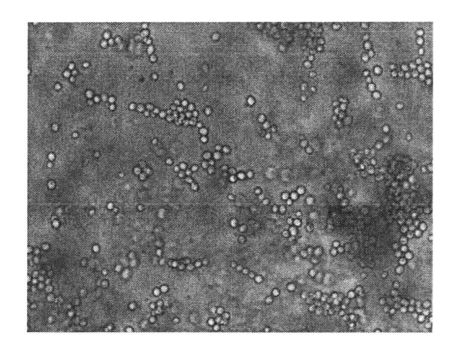
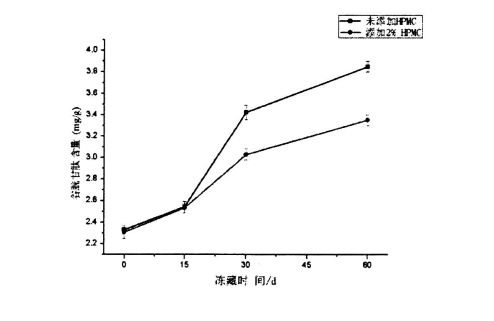
Kamar yadda aka nuna a Hoto 5.4, abun ciki na glutatatoni ya karu ba tare da la'akari da HPMC ba ko a'a, kuma babu shi, kuma babu mahimmanci tsakanin ƙari daban-daban. Wannan na iya zama saboda wasu daga cikin mai aiki mai sanyi yi amfani da su sanya kullu ba su da ƙarancin damuwa da haƙuri da haƙuri. Under the condition of low temperature freezing, the cells die, and then glutathione is released, which is only related to the characteristics of the yeast itself. Yana da alaƙa da yanayin waje, amma ba shi da alaƙa da adadin HPMC. Sabili da haka, abun ciki na GlatatHoni ya ƙara yawan kwanduna 15 na daskarewa kuma babu mahimmanci tsakanin su biyun. However, with the further extension of the freezing time, the increase of glutathione content decreased with the increase of HPMC addition, and the glutathione content of the bacterial solution without HPMC was increased from 2.329a: 0.040mg/ g (frozen storage for 0 days) increased to 3.8514-0.051 mg/g (frozen storage for 60 days); while the yeast liquid added 2% HPMC, its glutathione content increased from 2.307+0 .058 mg/g (frozen storage for 0 days) rose to 3.351+0.051 mg/g (frozen storage for 60 days). This further indicated that HPMC could better protect yeast cells and reduce the death of yeast, thereby reducing the content of glutathione released to the outside of the cell. This is mainly because HPMC can reduce the number of ice crystals, thereby effectively reducing the stress of ice crystals to yeast and inhibiting the increase of extracellular release of glutathione.
Yeast is an indispensable and important component in fermented flour products, and its fermentation activity will directly affect the quality of the final product. A cikin wannan gwajin, tasirin kariya na HPMC akan yisti a cikin tsarin da aka daskararru mai ban tsoro, da kuma lambar yaji mai rayuwa a cikin daskararre. Ta hanyar gwaje-gwajen, an gano cewa Bugu da ƙari na HPMC na iya kula da fermentation na yisti, da kuma rage digiri na daskarewa na kullu bayan kullun na ƙirar samfurin ƙarshe; Bugu da kari, ƙari na HPMC yadda ya dace da rage lambar tsira ta hanyar da aka rage, ta haka ne ta rage lalacewar hanyar glutatatoni. This suggests that HPMC can protect yeast by inhibiting the formation and growth of ice crystals.
Lokaci: Oct-08-2022







